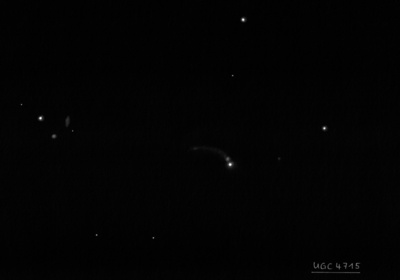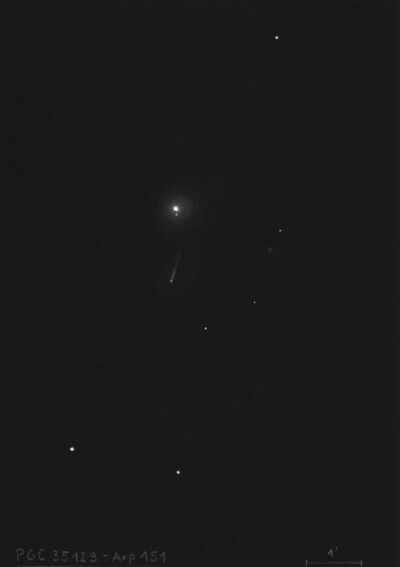The Big Dipper is one of the oldest and perhaps most famous constellations today, featuring a striking pattern of seven bright stars called the Big Dipper. In the older conception, only the part of the constellation consisting of the seven main stars α (1.79mag), β (2.37mag), γ (2.44mag), δ (3.31mag), ε (1.77mag ), ζ (2.09mag), η (1.86mag) Ursa Maioris was considered to be the Big Dipper, and the constellation as a whole is referred to in almost all languages as the Big Dipper, after the Latin name Ursa Maior. Today, we often see the common name of the Big Dipper, but it refers to the entire constellation. In "modern" America, the figure is known as the Great Dipper. The conspicuous grouping of the Great Dipper is not entirely by chance such an arrangement of individual constants. All of the stars except Dubhe and Benatnash are nearly equidistant from us - 74 to 80 light years away - and are part of, indeed the core of, the so-called "Bear Stream," a diffuse cluster of stars moving together in the same direction in space. In addition to a few less bright stars in the same part of the sky - 37, 38, 78, 80 Uma and 21 Leo minor - this stream includes some other stars that are located in completely different places in the celestial vault and have very similar motions through space. These include Sirius of the Big Dog, Gemma of the Northern Crown, δ and ζ Leonis, β Eridani, δ Aquarii, γ Ceti, α Ophiuchi, ι Cephei, β Aurigae. However, since they are separated by several hundred light-years in space, we cannot consider the Bear Stream as an open cluster. Its center is about 75 light-years away, making it our closest physical star cluster, so close that we don't even see it together in the sky. In space, its core occupies an area roughly 32 by 12 light years. But the sun, which is not part of it, lies roughly at its edge. Relative to the Sun, the Bear Stream is moving at about 15 km/s towards a point roughly at the boundary of the constellations Sagittarius and Capricorn.
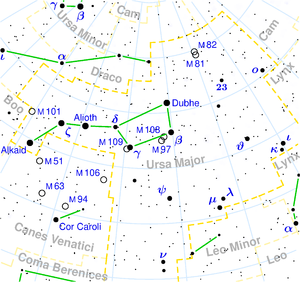
In the mid-1960s, astronomers analyzing images from the Palomar Sky Survey realized that the sky near the North Celestial Pole was obscured by a little-known dust complex. Some dust clouds were later catalogued by B. T. Lynd and described by Alan Sandage. In the late 1990s, IRAS and DIBHE, two satellites with FIR (far infrared) sensors, collected a wealth of information that finally revealed the full extent of the phenomenon. Detailed maps show that a large amount of dust (covering the constellations of the Big and Little Bear, Cephei, Giraffe and Lynx) stretches from the galactic plane roughly towards the north galactic pole, at a distance of about 300 pc from it. Although the nebulae are very faint in many places, they are not uniform and form dense clouds, bundles, filaments and other recognizable structures that should be given close attention. Like other components of interstellar material, they consist of dust particles, hydrogen, carbon monoxide, and other components.
In addition, these nebulae are unique in that they do not reflect, scatter or shine due to an individual star or star cluster (a feature of most nebulae in the plane of our Galaxy). Properly speaking, we can see these nebulae because they reflect light and are ionized by the total power of all the stars in the Milky Way! They have both reflection (dust scatters blue light) and emission characteristics (ERE - red emission, 600-1000 nanometer band). In short, dark nebulae near the galactic equator are lit up by the Milky Way! It may not be that surprising, but the history of visual observation goes back a long way in this case. In fact, if anyone was seriously interested in this particular field back then, they probably had the opportunity to notice things in the sky that we miss due to light pollution. In 1811, William Herschel compiled a list of 52 areas of the background sky that gave him a hazy impression. Northwest of the galaxy M82, he describes a 1.6-degree area covered in whitish haze. In 2004, an amateur astronomer noticed a faint smudge near galaxies M81-82 in a photo taken with a remotely controlled telescope in the mountains of New Mexico, which is now identified with the Vulcan Nebula, the brightest part of this complex, and probably within the range of an experienced observer.
Alioth (ε UMa) - The brightest star of the constellation. It is a short-period variable star and also a binary star, with components having an orbital period of 4.15 years, which can only be discerned through spectroscopic methods. The variation in its brightness in a period of 5.09 days is only within a range of 0.1mag and therefore cannot be observed with the naked eye. The star belongs to the type of stars α2 Canum Venaticorum, which also exhibit variations in their magnetic field.
Mizar a Alcor (ζ a 80 UMa) - The most famous binary star, which Arabs used to call "guide" or "sharpness tester of vision". The mutual distance between the two stars is 12', so a healthy eye can easily distinguish them practically always. They form a nice pair even in a telescope.
ξ UMa - The first binary star, for which the orbital path of its components was calculated, took place 60 years ago. It was achieved in 1828 by the French astronomer Felix Savary. It consists of golden components with a brightness of 4.3 mag and 4.8 mag, separated by 3 billion kilometers. Around 1970, they had a mutual separation of 3", and could easily be distinguished even with small telescopes. Then their mutual separation decreased, reaching its minimum in 1992 - 0.8". Today, this value is around 2", so a telescope with an 8 cm objective diameter is sufficient for their resolution.
Groombridge 1830 - A nearby star, which has the third fastest known motion after Barnard's Star and Kapteyn's Star - 7.04" per year. In about 100,000 years, the star will move from Ursa Major to the constellation of Canis Major! Because it is 28 light-years away, its rapid apparent motion is more a result of its actual space velocity than its proximity. Such stars are part of the Galactic Halo and therefore as old as globular clusters. Arcturus in Boötes is their brightest example.
Lalande 21185 - The nearby red dwarf, which has a brightness of 7.49 mag, is located at a distance of 8.1 light-years and is our fourth closest star after the Alpha Centauri system, Barnard's Star from Ophiuchus, and Wolf 359 from Leo. It has the 8th largest known proper motion - it moves across the sky by 4.78" per year. This red dwarf has an absolute magnitude of +10.5, which corresponds to a luminosity of 0.0048 times that of the Sun. Lalande 21185 has a companion, but it has never been visually observed.
M 81
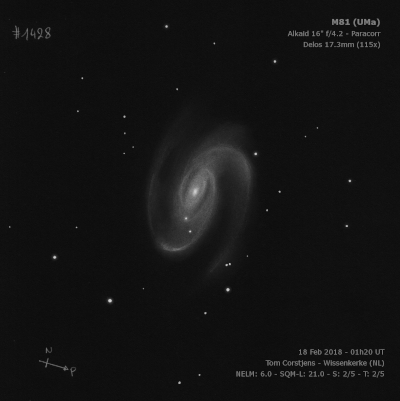
Johann Bode discovered M81 = NGC 3031 = h649, along with M82, on 31 Dec 1774. Pierre Méchain independently discovered M81 in Aug 1779. On 30 Sep 1802, William Herschel recorded "vB, eL; it very nearly fills all the field, it loses itself imperceptibly, mE np sf; I can trace it nearly 1/2° in extent beyond the brightest part." On 28 Oct 1831 (sweep 377), John Herschel wrote, "eB; eL; E, pos = 156°, gb and svmbM, with faint rays of light nearly to extremities of field (15'). The most condensed part is 4' l and 3' br." He mistakenly called this galaxy M82 in the Slough Catalogue.
200/250mm - 8" very bright, bright core, large oval halo, elongated NW-SE, two faint stars involved.
300/350mm - 13.1" (1/18/85): extremely faint arm attached at the southeast end near two stars and curves to the east.
400/500mm - 17.5" (3/23/85): very bright, very large, elongated 2:1 NNW-SSE, about 16'x8', large oval bright middle, bright core, nearly stellar nucleus. Two mag 11.5 and 11.9 stars are superimposed in the halo at the south edge of the core. An easily visible spiral arm is attached near these two stars at the south end of the core. This arm curves due north along the east side and is well separated from the main body. A second arm was suspected on 10/12/85 as a short extension curving around the NNW end towards a mag 12 star at the WNW edge of the halo and was described as "shorter and much less prominent, though definitely seen" on 1/31/87. Mag 8.7 SAO 15020 (∑1386 = 9.3/9.3 at 2") lies 10' SSW and the striking double star ∑1387 = 10.7/10.7 at 9" is 8' SSW. Forms a very striking pair at low power with M82 37' N. The bright supernova 1993j was located 3' SSW of the core and formed a right triangle with the two mag 11.5/11.9 stars south of the core.
900/1200mm - 48" (4/15/10): dazzling view of M81 at 267x (21mm Ethos) and 330x (17mm Nagler). The galaxy is elongated 2:1 NNW-SSE and extends at least 20'x10'. The brightness level increases gradually to the center from the large, very bright oval core but is punctuated at the center by an extremely bright, quasi-stellar nucleus. A bright spiral arm attaches to the galaxy on the northwest end and bends abruptly to the south, passing across a mag 12 star located 5' NW of center. As it heads southeast, the arm separates from the main glow of the galaxy and can be traced as it passes just north of double star STF 1387 = 10.8/10.8 at 9", ending to the northeast of the striking double star STF 1386 = 9.3/9.3 at 2.1". The total length of this arm is ~15'. The second main arm is more prominent, attaching to the main body on the south end. This arm is much brighter in a narrow arc as it curves around at its south end. The southern arm is still relatively narrow with a very well defined edge as it sweeps NNW and gradually separates from the main body.
Holmberg IX was visible 10.5' E of the center of M81. With this dwarf galaxy centered in the eyepiece, the outer halo of M81 was visible near the edge of the field. At 330x it appeared very faint, fairly large, 2' diameter, round, low even surface brightness with no noticeable concentration. The galaxy is nestled within a kite asterism including a mag 13 star 1.3' S.
Notes by Steve Gottlieb
M 101
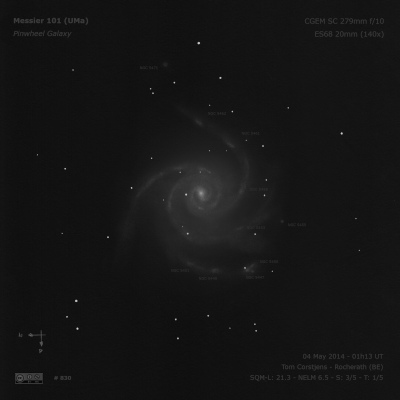
Pierre Méchain discovered M101 = NGC 5457 = h1744 on 27 Mar 1781. On 14 Apr 1789 (sweep 921), William Herschel described "a very bright small nucleus with extensive nebulosity, pretty well determined on the preceding side, but very diffuse to the north following. Includes the two following nebulae [III-788 = NGC 5461 and III-789 = NGC 5462], and seems to extend 20', perhaps 30' or more."
Bindon Stoney (LdR's assistant) sketched the various HII knots, spiral arms and superimposed stars and measured offsets in 1851. Samuel Hunter's superb sketch from 29 Apr 1861 was included at the last minute in the 1861 publication. This is probably the finest and most accurate sketch of a spiral galaxy done at Birr Castle and is very favorably compared with the DSS.
M101 has had 4 supernovae, the first (SN 1909A) was discovered by Max Wolf. It was announced as a variable star in Feb 1909 and assigned the designation SS UMa. The others are SN 1951H, SN 1970G and Type Ia SN 2011fe, which reached mag 10.9.
300/350mm - 13.1" (6/4/84): four HII regions resolved including NGC 5447, NGC 5458, NGC 5461, NGC 5462.
13.1" (4/24/82): fairly bright, very large, round, about 20' diameter, bright core. Fairly low surface brightness but beautifully resolved into several distinct arms and sections of arms with a pinwheel design. Obvious mottling along the spiral arms which appear clumpy with two or more easily recognized HII regions. At least six stars are superimposed.
400/500mm - 18" (6/21/03 and 6/28/03): the following HII regions were observed --
NGC 5447: at 215x this fairly prominent HII region appeared as an elongated patch oriented NNW-SSE, perhaps 25"x8", located just south of a mag 13.5 star. At 323x this patch clearly resolved into two sections -- within 30" of the star is a very compact knot, ~6"-10" diameter. There may be a small gap to the south with a larger extension to the SSE (this is NGC 5450). Located on the opposite side of M101 as NGC 5462.
NGC 5449: marginal object at 323x, but backing down to 215x a weak but definite glow was visible, perhaps 15"-20" diameter. Located 3.5' N of NGC 5457. NGC 5450: just resolved from NGC 5447 at 323x and was an elongated patch oriented NNW-SSE, ~20"x6". The entire complex spans ~45".
NGC 5451: very difficult, low surface brightness glow, ~10"-15" in size, requiring averted vision to glimpse. More difficult than two mag 15.5 stars separated by 13", which are location 1' WSW. The combined glow of these stars could easily mislead the observer into logging these as NGC 5451! In fact on 6/21/03 I initially picked up a small, hazy glow nearly collinear with a mag 12.9 star just north of the core of M101 and a slightly fainter star due west. But in good moments, this very small glow resolved into two stellar objects, probably appearing slightly hazy due to the background glow of the outer halo. After a more careful view, I noticed an extremely faint knot with averted vision, ~15" diameter, located ~2' ENE of this pair -- this is NGC 5451.
NGC 5453: required averted and concentration to confirm a small, low surface brightness glow, just visible over the background glow of the spiral arm this HII region resides. In fact, between NGC 5453 and the core is an inner arm which contains a couple of HII knots which are more evident!
Anon knot: two small, low contrast knots are visible in the spiral arm that is attached on the west side of the core of M101 and wraps around the south side towards the east. These are situated just 1.7' SW of the center of M101. Although this knotty structure does not have a NGC number it is slightly more evident than a few of the faintest NGC HII regions.
NGC 5455: compact knot, round, easily identified as forms the southern vertex of a triangle with two 13th magnitude stars to the NW and NE. At moments, a stellar nucleus or superimposed star pops out at 323x.
NGC 5458: very faint glow 3' S of the core of M101 on a line between a 13th magnitude star ~7' S of the center of M101. Requires averted for a definite sighting and appears to have a low, even surface brightness, ~20" diameter. Easier to view than NGC 5453.
NGC 5461: at 435x (5.2mm Pentax) a fairly bright quasi-stellar knot is attached at the NE end with a relatively faint extension (even surface brightness) extending to the SW. On 6/21 at 215x, this prominent HII region has a high surface brightness and stands out well. Increasing the power to 435x, there is a stellar or quasi-stellar core offset at the NE end with a faint extension to the SW. Backing down to 323x and using a UHC filter, the glow decreases in size, but the star-like core seems to increase slightly in contrast. NGC 5462: this HII region is probably the largest continuous piece. It appears very elongated 3:1 or 7:2 SW-NE, roughly 60"x18". On 6/21 appeared fairly bright and relatively large, elongated 3:1, ~50"x17" SW-NE. This HII region has an irregular surface brightness with a bright, nearly stellar knot at the NE end.
NGC 5471: highest surface brightness of any of the HII regions in M101. Appears very similar to a small, elliptical galaxy -- even contains a small, brighter core. Situated beyond the main glow of the galaxy, 11.5' NE of the core of M101. On 6/21 at 323x appears similar to a compact, round galaxy. Furthest NE of all the HII regions and well separated from the main glow of M101. Interestingly, this was one of the few HII regions that did show a positive contrast response to a UHC filter at 161x and 215x.
600/800mm - 24" (5/24/20): at 375x; I identified all visible HII regions and stellar associations in M101, 10 of which have NGC designations (5447, 5449, 5450, 5451, 5453, 5455, 5458, 5461, 5462 and 5471). In addition, I logged 4 additional low contrast knots from Banich's 2013 article in Sky & Telescope.
Notes by Steve Gottlieb
M 82
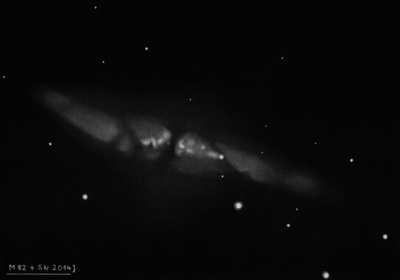
10x50 binoculars: faintly visible though easier in 15x50's.
Johann Bode discovered M82 = NGC 3034 = H IV-79, along with M81, on 31 Dec 1774. Pierre Méchain independently discovered M82 in Aug 1779.
M82 is not in William Herschel's published catalogues, though on 8 Nov 1801 (sweep 1100) he noted "eB, mE sp-nf, about 10' long" and on 30 Sep 1802 (sweep 1112) he logged "a vB, beautiful ray of light, brightest in the middle of all the length, about 8' long and 2 or 3' broad." John Herschel added it as one of the 8 "HON" objects ("Herschel omitted nebulae") in the Appendix to his Cape Observations (and in the GC as IV-79), as WH assumed it was a new discovery on his last sweep on 30 Sep 1802!
The first published comment about dark lanes was made by Ralph Copeland at Birr Castle on 21 May 1871. He noted "A most extraordinary object, at least 10' in length, and crossed by several dark bands."
200/250mm - 8" bright, spindle, mottled. A dark wedge cuts into the galaxy near the center from the south side.
300/350mm - 13.1" (11/5/83): two obvious dark lanes.
400/500mm - 17.5" (10/12/85): very bright, large, edge-on 4:1 WSW-ENE, 10' x 2.5', large bright irregular core. Very mottled with an unusually high surface brightness. Unique appearance with several dark cuts oblique to the major axis including a prominent wedge or cut nearly through the center. A mag 10 star is just south of the SW end 5.8' from the center
900/1200mm - 48" (4/15/10): stunning view at 330x with numerous irregular dark rifts slicing up the mottled, clumpy surface. Several very small, bright knots or condensations (Super Star Clusters - SSCs) are just west of a dark wedge that pierces the galaxy on the south side and tapers as it cuts across the center at an oblique angle. The very bright section of the galaxy to the northeast of the dark absorption wedge also displays mottled structure. Another prominent dark inclusion cuts into the galaxy from the north on the northeast side of the galaxy. A very faint extension of low surface brightness haze (the superwind outflow) bulges out from the main portion of the galaxy on the south side. This glow is west of the dark wedge and east of a mag 10.5 star located 5.8' SW of center. On images this large bulge appears to explode out from the galaxy with filamentary structure. Overall, there was too much visible structure to describe from a couple of minutes at the eyepiece.
Notes by Steve Gottlieb
M 109
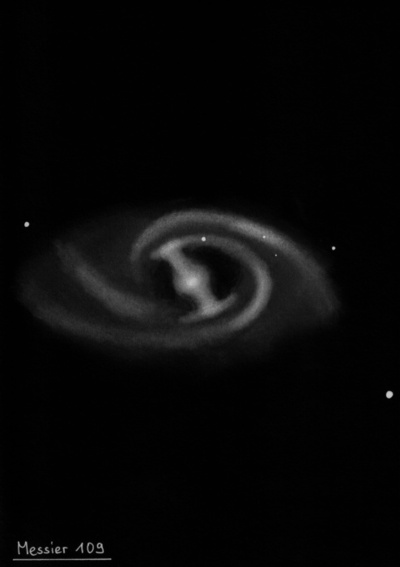
Charles Messier probably discovered M109 = NGC 3992 = H IV-61 = h1030 in March or April 1781 and added a position by hand in his personal copy of the catalog. Méchain has been given credit for discovery of this object, but according to the SEDS page, his position corresponds well with NGC 3953, not NGC 3992. See http://www.astrobril.nl/FortinOther.html#M109
WH independently discovered NGC 3992 = H IV-61 on 12 Apr 1789 (sweep 919) and recorded "pB, cB Ncl with vF extended branches about 30° np to sf, 5 or 6' long, 3 or 4' br." He recorded it again on the next sweep as "cB, vL, Br Ncl with vF elongated branches 7 or 8' long"
300/350mm - 13.1" (3/24/84): fairly bright, large, elongated SW-NE, bright core, diffuse halo. A star is superimposed NW of the core.
400/500mm - 17.5" (3/19/88): bright, large, elongated 5:3 SW-NE, at least 6.0'x3.5', broadly concentrated halo, large faint halo. A mag 13 star is superimposed on the halo 50" NNW of center. A mag 13 star is at the NE edge of the halo 3.4' from center. Located 5.1' NE of mag 9.3 SAO 28199 and 39' SE of mag 2.4 Gamma UMa. Forms a pair with UGC 6923 15' SSW.
900/1200mm - 48" (4/20/17): stunning showpiece barred spiral! The central bar extends 1.5' in length SW-NE and is highlighted by an extremely bright, rounder nucleus. Striking spiral arms wrap around the bar/nucleus forming an oval ring, with brighter "handles" at the ends of the bar. A pair of outer spiral arms, ~6'x4', extend west on the north side and east on the south side. A mag 13 star is superimposed [50" NNW of center].
Notes by Steve Gottlieb
M 97
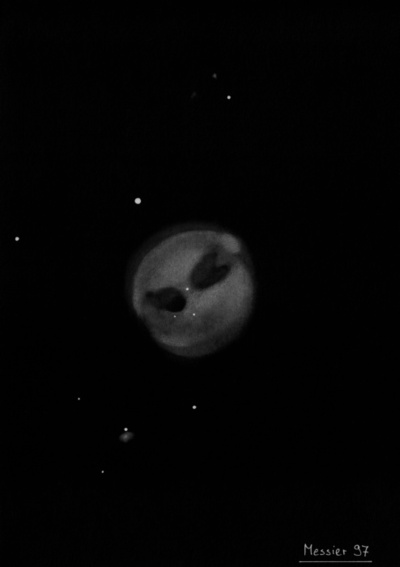
Pierre Méchain discovered M97 = NGC 3587 = h838 on 16 Feb 1781. In 1789 William Herschel described (with his 18.7") "considerably bright, globular, of equal light throughout, with a diminishing border of no great extent. About 3' diameter."
A total of 45 observations were made at Birr Castle. The dark holes were first recorded by assistant William Rambaut on 5 Mar 1848: "Saw two dark and very large spots in middle; Lord Rosse remarked that all round its edge the sky appeared darker than the average." On 11 March, Rosse wrote, "Brilliant star in the centre. After 5 min observation, detected the star to the right, which Dr. Robinson immediately saw. Round each star seems a black space." Rosse's or Rambaut's sketch, made in 1848, showed a distinct spiral structure ("a double perforation appears to partake of the structure both of the annular and spiral nebulae."). He was clearly influenced by the focus on resolving spiral structure in a variety of objects.
Between 1848 and early 1850 Lord Rosse and Johnstone Stoney made additional detailed sketches (one included in the 1850 publication) that vaguely resembled the face of an owl with two large dark holes or "eyes" punctuated by stars (one is the misplaced central star), additional darker streaks and patches, and fuzzy filaments extending out of the sides (perhaps to indicate an irregular fringe). On 13 Apr 1850, Stoney noted that only one star was visible. Wilhelm Tempel was highly critical, though, of Rosse's fanciful sketch when he drew the planetary in 1876 with the 11" refractor at the Arcetri Observatory in Florence.
The nickname "Owl Nebula" was never used by Lord Rosse in a published paper but in 1864 William Darby wrote that M97 was "familiarly known in the Parsontown Observatory as 'the owl nebula' from its resemblance to an owl." For an unusual interpretation of the appearance, Romney Robinson described the planetary on 11 Mar 1848 as "A most intricate group of spiral arcs disposed around two starry centers, looking like the visage of a monkey."
300/350mm - 13.1" (4/29/84): moderately bright, large, round. A single hole west of center is highly suspected.
13.1" (2/25/84): the darker "holes" visible were near the threshold. No central star seen at 166x-220x.
400/500mm - 17.5" (3/12/88): both holes definitely visible at 280x using a UHC filter.
17.5" (2/28/87): fairly bright, very large, round. Two low contrast darker "holes" are visible with averted vision which form the "eyes" of the "Owl Nebula". The southeast hole is darker but the northwest hole appears larger. Central star not visible.
600/800mm - 24" (2/9/13): although I didn't take notes on the structure of M97, the mag 16 central was readily visible using magnifications of 200x and higher.
900/1200mm - 48" (4/19/15): at 375x and 488x w/NPB filter; although the unfiltered view was excellent, adding a NPB filter at 488x ramped up the contrast! The two famous holes were very high contrast with the northwest eye slightly larger with a irregular outline. The slightly darker southeast eye has an easily visible star at the south edge [40" SSE of the central star]. In addition, a third very faint star (best seen unfiltered) is close west of this hole [37" SSE of center]. Overall the surface brightness of the planetary is irregular or mottled. It fades around the periphery creating a dimmer ragged circular rim of uneven brightness. The main bright portion of the planetary is slightly elongated NNW-SSE.
48" (4/15/10): the Owl Nebula was quite impressive at 330x (unfiltered) and exhibited a fascinating amount of detail. The mag 16 central star was easily visible at the center of the 3.4' disc. To the northwest and southeast of the central star are two large, darker "holes" (Owl's "eyes"), each roughly 45" in diameter. The southeast eye has a little more contrast and a very faint star is close to its southeast edge. The northwest eye is a little larger, though not quite as dark in the center. A mag 12 star lies 2.6' NE of center and a mag 14 star lies 3' S of center. MCG +09-19-014, a faint galaxy, lies 3.8' SSE adjacent to a mag 14.5 star. HCG 50 (faintest of the Hickson Compact Groups) lies 20' ESE.
Notes by Steve Gottlieb
M 108
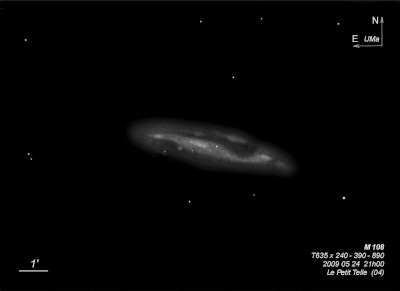
Pierre Méchain discovered M108 = NGC 3556 = V-46 = h831 on 16 Feb 1781 with a 3-inch refractor. Messier measured an accurate position and added it by hand to his personal copy of the catalogue, but a later edition was never published.
William Herschel independently discovered the galaxy on 17 Apr 1789 (sweep 922) and recorded H. V-46 as "vB, 10' long and 2' br, resolvable. An unconnected pB star in the middle." Herschel was credited with the discovery in the NGC. John Herschel made a single observation on 10 Feb 1831 (sweep 324) and wrote, "B; vL; p b r; vmE; pos 79°. Has a distinct star in centre and 1 or 2 vS stars elsewhere." At Birr Castle, M108 was observed 7 times, first on 13 Apr 1850. It was described in various observations as "twisted", "mottled", "patched and irregular", "knots".
300/350mm - 13.1" (2/25/84): fairly bright, very elongated, stellar nucleus.
400/500mm - 17.5" (2/25/84): very bright, very large, edge-on 4:1 WSW-ENE, 8.0'x2.0'. A mag 12 star is superimposed just west of center (V = 12.5) appearing similar to a bright stellar nucleus. Two fainter stars are also superimposed east of the core. A bright knot is visible west of the core (1.3' W of the star) and the region near the core appears dusty. A mag 12 star is just south of the west end, 4.9' from the center.
17.5" (3/12/88): very bright, very large, a bright star is superimposed near the center, knot visible west of the core.
900/1200mm - 48" (5/12/12): extremely bright and large, very elongated at least 4:1 WSW-ESE, ~8'x2'. M109 displayed a unique tortured appearance and was riddled with irregular dust lanes and patches. A very irregular dust lane courses through the galaxy along the major axis, but north of the core. A bright mag 12.5 Milky Way star is superimposed just west of center and east of this star is a bright, large elongated knot [HK83] 87. Very close west of the star is a small, faint knot [HK83] 108 and a large dust patch is just west of this knot. On the west edge of the dust patch (1.2' W of the star) is another bright, elongated knot with multiple HII designations including [HK83] 146.
Notes by Steve Gottlieb
IC 2574
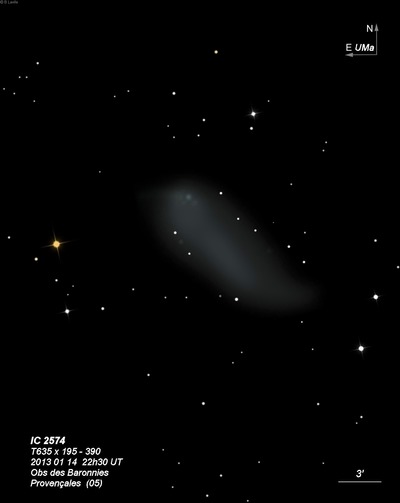
Edwin Coddington discovered IC 2574 at Lick Observatory on a plate of the M81/82 region taken on 17 and 20 Apr 1898 with the 6" Crocker telescope (Willard Lens). The discovery was announced in PASP 10, 123 (1898). Coddington noted he observed it visually on the 22nd with the 12-inch refractor. Also, on 19 May, Coddington obtained an additional photograph that showed "the different condensations to be connected by faint nebulous matter, and the whole to extend over an area fully 4' in width and 12' in length."
400/500mm - 17.5" (3/12/94): faint, very large, elongated 5:2 SW-NE, 7.0'x2.5', low surface brightness, no concentration. Four faint stars are near the north side. There is a fairly bright nonstellar HII region that is clearly visible at the NE end as a high surface brightness knot. Member of the M81 group (distance ~12 million l.y.).
900/1200mm - 48" (2/21/12): This large, low surface brightness dwarf irregular in the M81 group extended roughly 10'x4' SW-NE with only a weak, broad concentration. The galaxy is dominated by a giant star forming/HII complex near the NE end of the galaxy. At 375x, four separate, compact knots were easily resolved within a 1.2' region, though the brighter glow from the entire complex spans roughly 1.5'x1.0' from WSW to ENE. The brightest and largest knot carries the designation IC 2574:[HK83] #15, from Hodge and Kennicutt's "An Atlas of H II regions in 125 Galaxies" in AJ, 88, 296 (1983). This high surface brightness knot is very bright, slightly elongated N-S, 20"x15", and is situated at the NW vertex of the four knots. #13/34 is a fainter irregular knot of ~12" diameter at the NE vertex. #35 forms the SE vertex and appears as a faint, round knot, only 8"-10" in size, just 24" SSW of #13/#34. The knot at the SW vertex is not listed in the H-K atlas, but is catalogued in NED as radio source NVSS J102844+682809. It appeared similar to #35, though slightly elongated and situated only 20" S of #15. At 488x, a 5th knot was seen ~30" SW of #15, and appeared as a very faint, ill-defined 15" glow (this region contains #17 and #19).
Notes by Steve Gottlieb
NGC 4157
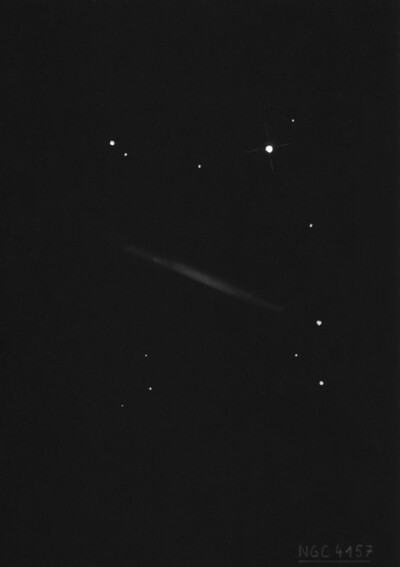
William Herschel discovered NGC 4157 = H I-208 = h1114 on 9 Mar 1788 (sweep 816) and recorded "F, mE from sp to nf, nearer the parallel, about 3' l and 3/4' broad." JH made the single observation "B; vmE; vglbM; 4' long." and d'Arrest measured the position twice.
200/250mm - 8" (3/28/81): faint, very elongated WSW-ENE, bright core. A mag 8 star is close NW.
400/500mm - 17.5" (5/2/92): bright, moderately large, edge-on 7:1 WSW-ENE, 5.0'x0.7', elongated bright core, extensions taper at ends. Located 4.3' SE of mag 8.0 SAO 28277. Two mag 10/10.5 stars oriented N-S are 3.8' SW and 5.1' SW and a mag 11 star lies 4.9' NE. This is a striking galaxy with several bright stars near adding to the view. Member of the M109 (NGC 3992) group = LGG 258.
Notes by Steve Gottlieb
NGC 2820
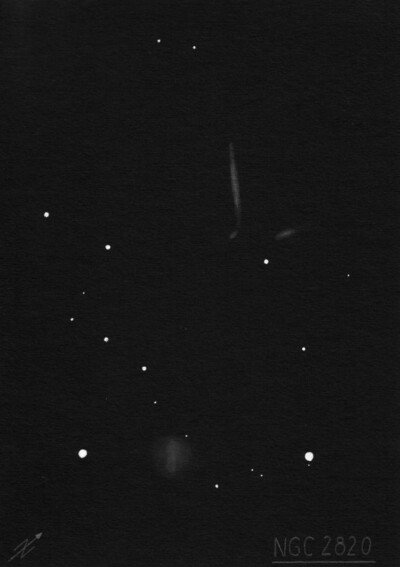
William Herschel discovered NGC 2820 = H II-869 on 3 Apr 1791 (sweep 1004) and recorded both as "Two nebulae. The first [NGC 2814] F, S, iF, the second [NGC 2820] F, pL, E. The place is that of the second, the other precedes it about 30 seconds and is nearly in the same parallel." Dreyer equated John Herschel's observation of h576 with H II-869 = NGC 2820, but his sweep data (checked by Wolfgang Steinicke) reveals h 576 = H II-868 =[NGC 2814. In addition, h579 = NGC 2816 is identical to NGC 2820, with John Herschel making a 3 3/4 error in reducing the position for h579. IC 2458, found by Guillaume Bigourdan on 14 Mar 1899, refers to the northeastern end of this galaxy and not the close companion NGC 2820A off the southwest end that is generally identified as IC 2458.
400/500mm - 17.5" (4/6/91): fairly faint, very thin edge-on 6:1 SW-NE with tapered ends, fairly low surface brightness, no noticeable core. Forms a contact pair with NGC 2820A 20" off the southwest tip. The companion is very faint, very small, elongated 2:1 SW-NE, very small brighter core. NGC 2820 is in a group with NGC 2814 4' W and NGC 2805 13' SW.
600/800mm - 24" (2/22/14): fairly bright, very large, very thin edge-on 7:1 WSW-ENE, ~2.8'x0.4', very weak concentration, mottled appearance though the surface brightness is not high. NGC 2820A dangles just south of the west-southwest edge. It appeared faint, small, oval 3:2 SSW-NNE, 18"x12", occasional stellar nucleus. NGC 2814, a smaller edge-on, lies 3.7' W.
Notes by Steve Gottlieb
NGC 2841
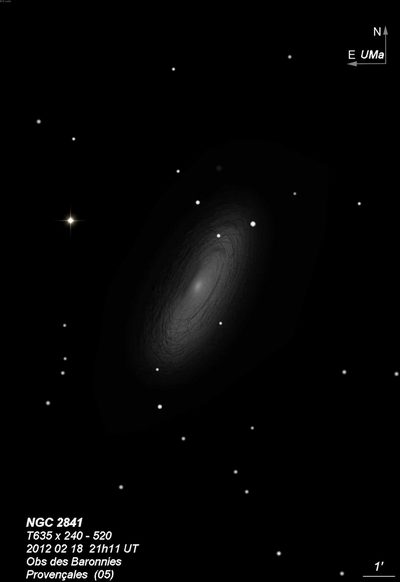
William Herschel discovered NGC 2841 = H I-205 = h584 on 9 Mar 1788 (sweep 815) and recorded "a very brilliant nebula, 5' or 6' long and 3 or 4' broad; it has a small bright nucleus with a faint chevelure about it, and two opposite very extensive branches." He published a sketch in his 1811 paper (Fig. 23) as an illlustration of "extended nebulae that show the progress of condensation [core and nucleus]." John Herschel described it on 17 Feb 1831 (sweep 328) as "vB; vmE; vsmbM; pos 150.8°; comes up to a nucleus, a star 10-11m; has 2 st not involved 11 & 12 m, and a 3rd 10 m perp to axis of neb."
This galaxy has hosted 4 supernovae; the earliest known is SN 1912A, which was discovered by Francis Pease in 1917 on a photograph taken with the 60-inch on 19 Feb 1912. It was independently found by Curtis.
300/350mm - 13.1" (1/18/85): bright, large, elongated 2:1 NW-SE, 6'x3'. Contains a very small, very bright nucleus. There is a sharp light cut-off on the east side due to dust. A mag 10 star is at the NW edge 2.8' from center and mag 8.6 SAO 27227 lies 4.8' NE.
Notes by Steve Gottlieb
NGC 3184
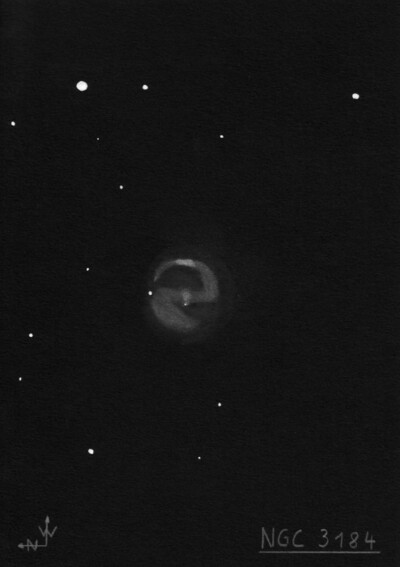
William Herschel discovered NGC 3184 = H I-168 = h688 = h689 on 18 Mar 1787 (sweep 716) and recorded "cB, R, near 8' dia, vgbM. A considerable star in the northern part of it but unconnected. John Herschel assigned two entries for this galaxy, h688 = H I-168 and h689, with the second entry a poor position for this face-on spiral.
Bindon Stoney, observing with LdR's 72" on 25 Jan 1851, logged "Is triple, neby perhaps extends round them all as far as the star north. h689 not seen." The following month, he commented "preceding part probably a portion of a ring." R.J. Mitchell sketched the the spiral structure on 1 Feb 1856 (fig 13, Plate XXVII in the 1861 publication). The sketch shows two brighter, elongated knots in the western arm and Dreyer catalogued these as NGC 3180 and 3181.
MCG mislabels the galaxy as NGC 3180.
400/500mm - 17.5" (4/4/92): fairly bright, large, slightly elongated ~N-S, large 4' halo has a fairly low surface brightness, very weak concentration, small brighter elongated core. There is an impression of spiral structure though it wasn't distinct. A mag 11.5 star is at the north edge of the halo 1.8' from the center. Located 40' W of Mu Ursa Majoris (V = 3.1).
900/1200mm - 48" (4/4/11): NGC 3184 is a beautiful face-on spiral with two main long arms and branches, along with several HII knots (two with NGC designations) in the arms. Contains a relatively small, very bright core, ~1' diameter with a sharp stellar nucleus. A mag 15-16 star is visible about 40" NE of the center near the edge of the core. One arm is attached on the east side of the core and winds counterclockwise around the south side of the core towards the west. The outer halo of the galaxy to the south of this arm has a much lower surface brightness. NGC 3181 is a bright, 15" knot (HII region/massive star cluster) embedded in this arm, 1.2' SW of the nucleus. The arm then continues spiraling outward as it heads north and contains NGC 3180, very small knot with a stellar core at 1.8' NW of the nucleus. This small knot is within a larger, slightly brighter portion of the arm. A second prominent arm is attached on the west side of the core and rotates counterclockwise around the north side towards the east. The surface brightness lowers on the east side and the arm splits into two branches. A mag 11.7 star is superimposed near the outer edge on the north side beyond the arm. Located 11' ESE of mag 6.6 HD 89053.
Notes by Steve Gottlieb
NGC 2768
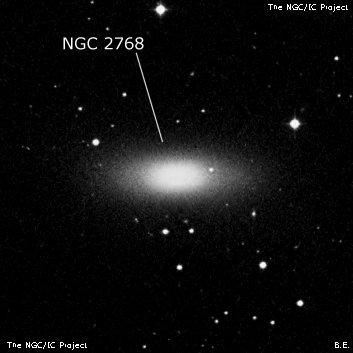
William Herschel discovered NGC 2768 = H I-250 = h555 on 19 Mar 1790 (sweep 952) and logged "vB, cL, lE, large bright nucleus in the middle." Caroline's reduced position was on the eastern side of the halo of UGC 4821.
200/250mm - 8" fairly bright, elongated, bright core. Located 15' SE of a wide mag 8/9 pair.
400/500mm - 17.5" (3/28/92): very bright, moderately large, elongated 2:1 E-W, faint halo extends to 3.0'x1.5' with averted. The halo increases to a very bright core with a high surface brightness and a stellar nucleus. Several bright stars are in the field including two mag 10 stars 3.5' WNW and 4.7' N of center.
Notes by Steve Gottlieb
NGC 3077
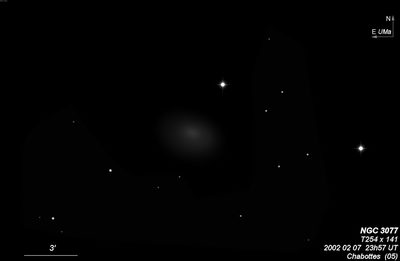
William Herschel discovered NGC 3077 = H I-286 = h658 on 8 Nov 1801 (sweep 1100) and remarked "vB, cL, R, vgmbM. On the north-following side there is a faint ray interrupting the roundness." Caroline's reduced position is 8' too far south. Wilhelm Struve independently found the galaxy in 1825 or 1826 and included in his list of 9 "Nebulae dectae" in an appendix to his main catalogue of double stars (∑ 3). John Herschel's position, measured on 28 Oct 1831 (sweep 377) was accurate in declination, but 1 min of RA too far west. Ralph Copeland, observing with LdR's 72" on 26 Dec 1873, noted "vB, L, R, comet like with 2 streams of neby towards the south."
400/500mm - 17.5" (3/23/85): fairly bright, fairly large outer halo elongated SW-NE, increases to brighter core. Mag 7.9 SAO 15054 (∑1400 = 8.0/9.8 at 3.4") lies off the NW side 3.8' from the center. Located 45' ESE of M81 (member of the M81 group).
600/800mm - 24" (4/20/14): at 260x appeared very bright, very large, oval 4:3 SW-NE, large bright core, gradually increases to a small brighter inner core and occasionally a faint stellar nucleus. The outer halo seems brighter or more extensive on the north-following side and gradually fades, so the periphery has a very low surface brightness. Two similar unequal doubles are in the field: ∑1400 = 8.0/9.8 at 3.4" lies 3.8' NW and ∑1398 = 8.1/11.4 at 3.6" lies 10".
Notes by Steve Gottlieb
NGC 4051
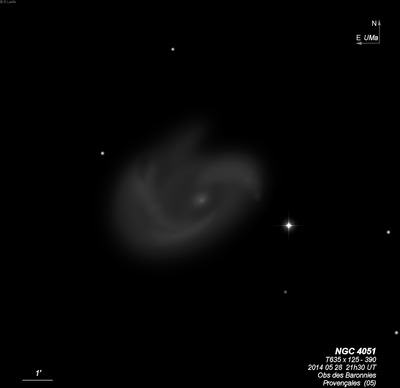
William Herschel discovered NGC 4051 = H IV-56 = h1061 on 6 Feb 1788 (sweep 810) and recorded "cB, iR, cBN with extensive chevelure about 5' dia." His position matches UGC 7030.
Bindon Stoney sketched the galaxy on 3 May 1851 as an "S" shaped barred spiral (in LdR's 1861 publication). He captured the structure very accurately and noted, "Spiral. I suspect the f branch extends to [star] alpha [on the northeast end]." On 19 Apr 1857, R.J. Mitchell logged "The p branch seems to me the brighter rather of the two, and more suddenly curved than the f one, both of them look not quite so sharp as given in the drawing."
NGC 4051 is one of the original 6 galaxies studied by Seyfert in his seminal 1943 paper "Nuclear Emission in Spiral Nebulae".
400/500mm - 17.5" (3/8/97): fairly bright, large, ~4.0'x2.5' NW-SE. Nearly extends to a mag 11 star 2.2' W. Very bright, very small core increasing to a bright stellar nucleus (original Seyfert galaxy list). The galaxy shows signs of spiral structure and there appears to be a short outer spiral arm attached at the SE end hooking north separated by a slightly darker region between the main body (verified on photo). This galaxy, along with NGC 3938 and NGC 4111, are the brightest members of the NGC 4111 group (LGG 269) in the UMa Cloud.
900/1200mm - 48" (5/10/18): at 375x; NGC 4051 is a highly structured S or Z-shaped barred spiral with easy HII knots and subtle details! This Seyfert galaxy is very sharply concentrated with a brilliant quasi-stellar nucleus! The bright core extends into a slightly brighter central region or bar elongated 2:1 NW-SE and just over 1.5' in length. The halo extends at ~4.5'x3.5' NW-SE.
A very obvious eastern arm is attached at the southeast end of the bar and angles at a 90° angle towards the northeast, pointing towards a mag 14.0 star [2.8' NE of center]. A low surface brightness thin arm [roughly 1.6' in length] angling SE to NW was visible on the north side. On the DSS this arm appears to emanate from the bright eastern arm though visually it appeared straight and completely detached.
A large knotty arm, attached at the northwest end, bends sharply towards the south. This arm is thick or wide at its root with a large brighter knot or region embedded (catalogued as [EKS96] #31 and #28 in the 1996 "Atlas of HII Regions in Nearby Seyfert Galaxies"). As the arm dips south it terminates at a faint 10" knot (#10), 1.4' W of center. In addition, an obvious, small bright knot (#52), ~8" diameter, is just south of the core [by 0.6']. This knot resides in a very thin arm (not seen) just south of the central region. Overall, I was very impressed with this gorgeous galaxy!
Notes by Steve Gottlieb
NGC 2976
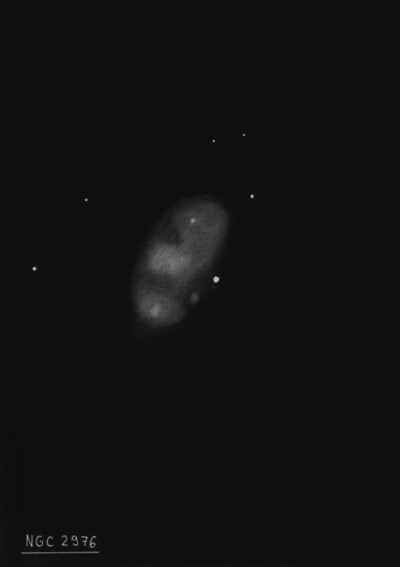
William Herschel discovered NGC 2976 = H I-285 = h625 on 8 Nov 1801 (sweep 1100) and recorded "vB, vL, E from np to sf, about 6' l and 2' br." John Herschel made a single observation on 2 Apr 1832 (sweep 411): "B; vL; mE in pos = 332.4°; vgvlbM, 3' l, 1' br; has several S stars in in, and one 12m nearly at right angles to the axis of extension." Several involved stars or nearby stars were micrometrically measured at Birr Castle.
200/250mm - 8" moderately bright, fairly large, elongated, even surface brightness.
400/500mm - 17.5" (2/8/91): bright, large, elongated 5:2 NW-SE, 4.5'x2.0', large brighter center but no core, mottled with an irregular patchy surface brightness. A mag 13 star is at the west edge 1.0' from the center and a mag 14 star is just off the NW edge 2.6' from center.
Notes by Steve Gottlieb
NGC 4605
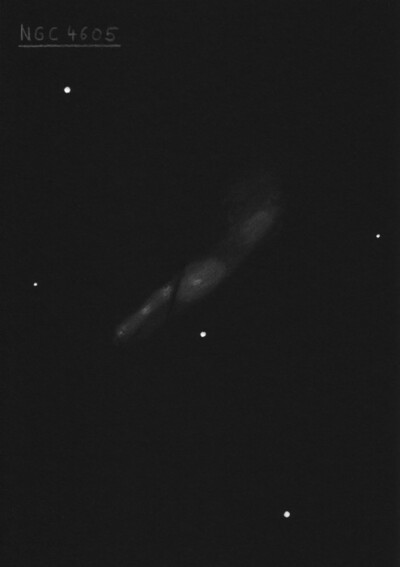
William Herschel discovered NGC 4605 = H I-254 = h1381 on 19 Mar 1790 (sweep 953) and recorded "eB, E, about 5' long in the parallel, all over equally bright, except just on the edges." JH made a single observation (sweep 344): "B; L; vmE; in pos 118.6°; glbM; 4' l and 1' br."
200/250mm - 8" bright, moderately large, very elongated NW-SE.
400/500mm - 18" (5/14/07): very bright, large, nearly edge-on 3:1 NW-SE. The relatively large, bulging core is mottled. The southeast extension is brighter, mottled (HII regions) and tapers towards the tip. The very tip of this extension appears to hook slightly towards the east. The fainter northwest extension is much more diffuse, is broader and fades at the ends. The major axis of the two extensions are slightly skewed with respect to each other as if they were bent at the center or possibly the brighter southeast extension is warped or distorted.
18" (5/8/04): very bright, large, quite elongated 5:2 ~NW-SE. Contains a relatively large, high surface brightness elongated core. This galaxy's structure is very unusual with careful viewing. The southeast extension is clearly brighter and more tapered than the northwest end. The surface brightness of the southeast extension is noticeably uneven with a mottled or splotchy appearance possibly from HII regions and an irregular distribution of dust. Near the center there is a slight bend or kink to the major axis, with the fainter northwest extension slightly misaligned. Also the northwest extension appears to fan out somewhat at the northwest edge and fade into the background.
Notes by Steve Gottlieb
NGC 3198
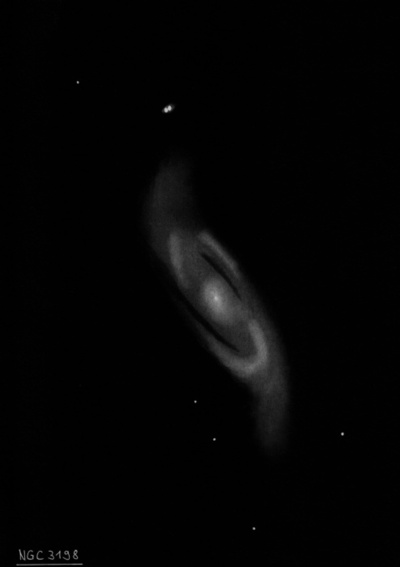
William Herschel discovered NGC 3198 = H I-199 = h695 on 15 Jan 1788 (sweep 800) and remarked "cB, mE, gbM, about 5' long and 2' broad from sp to nf." John Herschel wrote on 20 Mar 1828 (sweep 140), "F; vL; bM; mE; 6' large, 2.5' br; r[esolvable]." George Stoney, observing with LdR's 72" on 3 Mar 1850, noted "probably a faint spiral." It was included in the list of "Spiral or curvilinear" nebulae in LdR's 1850 PT paper. In later observations, a "dark vacuity ssp Nucl" was noted as well as "dark spaces throughout its length".
400/500mm - 17.5" (3/12/94): fairly bright, large, very elongated 3:1 SW-NE, 7.0'x2.5', broadly concentrated, brighter core has an indistinct elongated nucleus and an irregular surface brightness. Two mag 14 stars are close south (nearest is 2.0' from the center) and a mag 11 star is just off the NNE edge 3.5' from the center.
900/1200mm - 48" (5/4/16): at 375x; NGC 3198 is a showpiece, large spiral extending 7:2 SW-NE, ~8.0'x2.5'. Contains a bright, elongated central "bar", punctuated by a very small bright core that rises to a stellar nucleus. Slightly brighter patches are visible at the ends of the central region, where the spiral arms emerge. A tight inner arm is attached on the northeast end; it bends back sharply and closely parallels the central region, extending southwest for a length of ~3.5'. An outer low surface brightness arm sweeps clockwise on the southwest end. A symmetric outer arm on the northeast end (of slightly higher surface brightness) curls clockwise towards the west. The outer tip to tip diameter is nearly 8'. An uncatalogued fairly bright double star [separation ~3.7"] is 3.5' NNE of center, just beyond the halo and a mag 14 star is 2.2' SSE of center.
Notes by Steve Gottlieb
NGC 3941
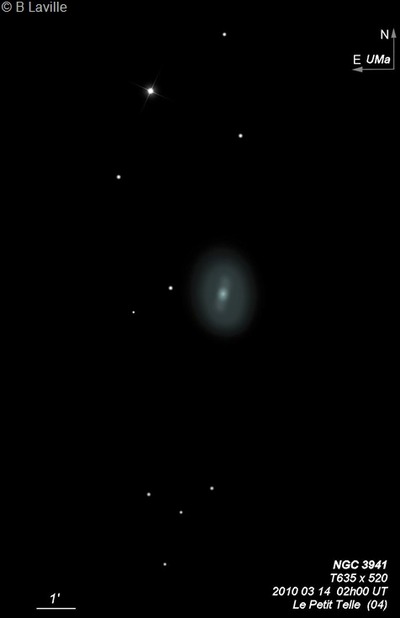
William Herschel discovered NGC 3941 = H I-173 = h1005 on 19 Mar 1787 (sweep 719) and recorded "vB, R, NM but very gradually diminishing about 2 1/2' diam." His position (CH's reduction) is 3' too far north. JH made three observation and measured a more accurate position. Samuel Hunter, observing with LdR's 72" on 17 Apr 1862, questioned if it was a "right-handed spiral?"
400/500mm - 17.5" (4/6/91): bright, fairly small, elongated 2:1 N-S, 2.5'x1.2', high surface brightness, small very bright mottled core, substellar nucleus, fairly small halo. A mag 13.5 star is 1.6' ENE of center.
600/800mm - 24" (2/15/18): at 200x; bright, fairly large, elongated 3:2 N-S, ~2.5'x1.8'. Sharply concentrated with an intense core. At 375x the core increases to a very small, quasi-stellar nucleus. Type Ia SN 2018pv (discovered on 3 Feb at the pre-max stage) was easily visible at 13th magnitude, but located only 4" E of center, right up against the edge of the bright nucleus.
Notes by Steve Gottlieb
NGC 3631
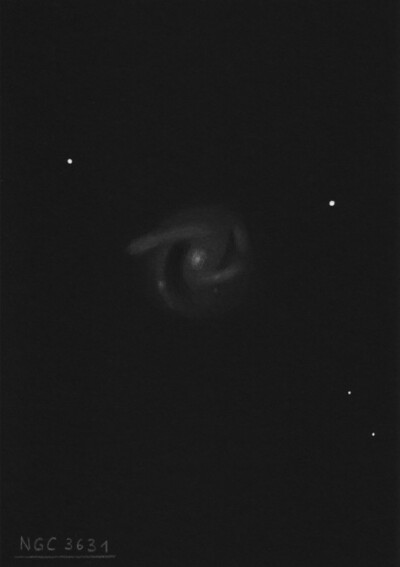
William Herschel discovered NGC 3631 = I-226 on 14 Apr 1789 (sweep 920) and recorded "cB, R, small br nucl and vF halo of considerable extent, 3' or 4' dia."
Four observations describing spiral arms were made at Birr Castle. On 30 Mar 1856, R.J. Mitchell recorded "Spiral, with I think, two arms thus (thumbnail sketch). The arms are broken and of unequal light. There are bright patches at alpha (preceding the nucleus), beta (south preceding arm) and gamma (end of bright north following arm)." A week later he logged "Spirality seen as in last observation. The following branch comes down past the other, doubling over it and seems to originate from the preceeding side of nucleus. Very patchy."
The1880 publication has a thumbnail sketch and the 1861 publication has a drawing (Plate XXVII, fig 20). Both show the main features that can be confirmed on the DSS.
400/500mm - 17.5" (4/1/95): bright, large, round, 3.5' diameter. Sharp concentration with a prominent core which brightens to a nearly stellar nucleus. The outer halo fades into the background and shows a hint of the spiral arm structure. Two mag 12-13 stars are 3.4' NE and 3.3' WNW of center.
900/1200mm - 48" (4/4/11): beautiful face-on spiral of 4' diameter with two long, winding arms and branching extensions! This very bright galaxy appeared sharply concentrated with an intensely bright small core that increased to an extremely bright stellar nucleus. A prominent patchy arm was attached on the west side of the core and rotated counterclockwise to the north, then bent sharply back in a straight line to the east end of the galaxy. What appeared to be an offshoot arm turned counterclockwise on the east side and continued all the way to the south end of the galaxy. The second arm was attached on the southeast end of the core and swept around the south side towards the west and then continued to the northwest end of the galaxy. An offshoot or another patchy arm continued east near the edge of the northern halo. The two main arms are nearly connected by a slightly brighter region on the south side. Member of the LGG 241 or UMa NED1 Group.
Notes by Steve Gottlieb
NGC 3726
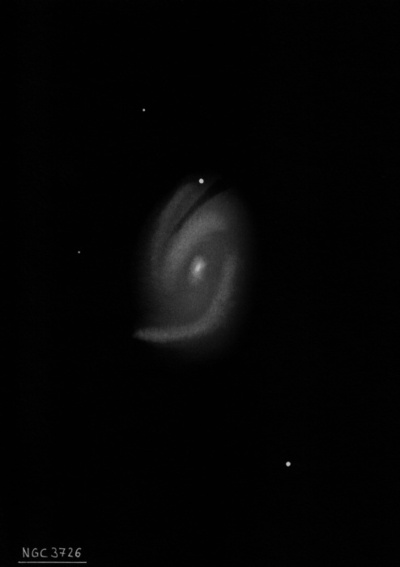
William Herschel discovered NGC 3726 = H II-730 = h910 on 5 Feb 1788 (sweep 808) and recorded "pB, bM, 4' long and 3' broad, r." His position is at the north edge of the galaxy. JH made two observations, first recording "pB; vL; E in meridian; vgbM; 4' l, 2' br; has a * at its northern extremity."
William Rambaut, observing with LdR on 26 Mar 1848, recorded "Before nebula came into the field of the large finding eyepiece Lord Rosse observed a vF neb p it about 2m nearly in the parallel [likely CGCG 242-042, which was ignored in the GC and NGC]. [NGC 3726] is tolerably bright nucleus almost in centre; Lord Rosse at intervals perceived traces of spiral arrangement; dark black elliptical stripe a little above the nucleus." R.J. Mitchell on 30 Mar 1856 wrote, "it appears of the shape annexed [sketch shows a dramatic "S" shaped (barred) spiral], which exaggerates. There can be no doubt of the bend upwards at Alpha [shows the southeast arm] and of the darkness about the nucleus." NGC 3726 was included in the list of spiral nebulae in the 1850 PT paper.
400/500mm - 17.5" (4/6/91): bright, large, oval 2:1 N-S, 5.0'x2.5', patchy mottled appearance, very small or stellar nucleus but no core. A mag 12 star is at the north tip 2.4' from the center. Member of the NGC 3877 subgroup with the NGC 3992 (M109) group.
900/1200mm - 48" (4/19/17): at 375x and 488x; very bright, very large spiral, extending 3:2 N-S, 4.5' or 5' x 3'. Contains a brighter, mottled central core that is sharply concentrated with an intensely bright roundish nucleus. Two obvious spiral arms are attached on the north and south end of the central region. The northern arm is brightest at its root near the northeast side of the core. It rotates clockwise and sharply curls west and southwest, then dims and ends west of the nucleus. This arm appeared a bit thicker than the DSS2 image. The southern arm is shoots straight southeast, and curls a bit east. The arm contains a couple of slightly brighter HII patches including NGC 3726:[BKB2006] 2, situated 1.4' south of center. The outer halo has a low surface brightness but extends to a mag 12.5 star 2.4' N of center.
Notes by Steve Gottlieb
NGC 3938
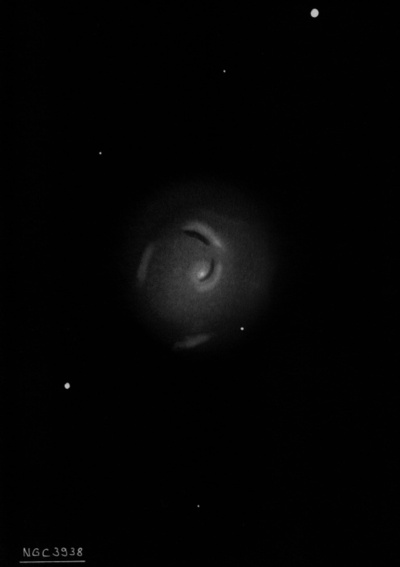
William Herschel discovered NGC 3938 = H I-203 = h1002 on 6 Feb 1788 (sweep 810) and recorded "cB, cL, R pBNM." JH made two observations, logging on sweep 248 "a superb nebula; B; vL; R; 3' diam; vgbM; r; is probably a globular cluster."
On 17 Mar 1849, Johnstone Stoney logged that he "Suspect it to be a spiral. Lord Rosse and I independently thought at moments that were saw a ring around the nucleus. Two years later, Bindon Stoney wrote "Spiral of the faintest class. The middle is pB, but branches vF. Conjectured form as in diagram [which shows a 3-armed spiral]." Listed as "Spiral or curvilinear" in LdR's 1850 PT paper.
400/500mm - 17.5" (4/6/91): fairly bright, fairly large, large round halo, 3'x3', fairly weak concentration, core appears elongated E-W, faint stellar nucleus embedded. This galaxy, along with NGC 4051 and NGC 4111, are the brightest members of the NGC 4111 group (LGG 269) in the UMa Cloud.
900/1200mm - 48" (5/10/18): at 375x; I was very impressed with this gorgeous face-on spiral! Very bright, roundish, over 4' diameter, strongly concentrated with a well defined, very bright round core and bright stellar nucleus. Three principal spiral arms were easily visible. A thin inner arm can be traced 180°; it originates just south of the core and curls counterclockwise towards the west. It dims out as it extends north along the west side [~0.6' from center] but brightens noticeably as it spirals out and detaches from the central region on the northwest side, ending nearly due north [1.3' from center]. A shorter outer arm on the west side was easily visible [at a radius of 1.5'], curving 90° from the southwest to the northwest. These two western arms are separated by a darker interarm gap
The eastern arms have a noticeably lower contrast. The inner eastern arm can be traced with the help of a wide, darker dust lane immediately to its east. The arm disappears into the halo on the south side but just further west two small HII knots, ~6" diameter each, were visible. The knots are separated by 20" E-W, and isolated on the southwest edge of the halo. The 1983 Hodge-Kennicutt "Atlas of HII regions in 125 galaxies" includes multiple designations including #120 [1.4' SSW of center] and #140 [1.5' SW of center]. A 15th magnitude star is ~1' W, just beyond the halo on the SW end.
The outer arm on the eastern edge of the halo could mostly be traced by three HII knots within the arm. The largest is an easily visible 12"-15" patch (#23) on the NE edge of the halo [2.2' from center]. Also 2' ENE of center are a pair of faint knots only ~5" diameter. These are separated by 12" in a N-S orientation, with the northern knot (#3) slightly brighter than the southern (#4).
Notes by Steve Gottlieb
NGC 3893
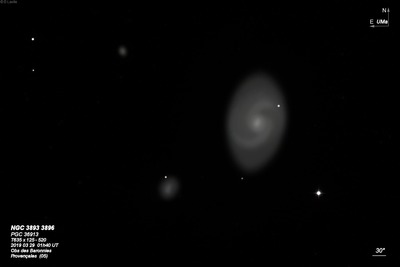
William Herschel discovered NGC 3893 = H II-738 = h982 on 9 Mar 1788 (sweep 816) and recorded "pB, pL, R, mbM." His position is accurate. JH logged "B; pL; R; gb and psmbM; 60"."
Bindon Stoney, observing on 15 Apr 1852 with LdR's 72", logged "Spiral probably, knot in south edge and a * outside preceding edge." The next night he also noted the "spiral branch seems to start from the south edge and go round the following and n sides as far as the preceding star." Further observations of the spiral structure were made in 1857 and 1861.
400/500mm - 17.5" (4/7/89): fairly bright, moderately large, oval 3:2 NNW-SSE, 2.4'x1.6', broad moderate concentration, small bright core. There is a hint of spiral structure with an impression of an arm attached at the SW end trailing to the east. A mag 13.5 star is involved at the NW side 1.0' from the center and a mag 10.5 star is 3.1' SW. Forms a pair with NGC 3896 3.7' SE. NGC 3893 is a member of the NGC 3877 subgroup of the NGC 3992 (M109) group = LGG 258.
900/1200mm - 48" (5/9/18): I was quite impressed with this gorgeous asymmetric spiral. At 488x and 610x it appeared very bright, very large, oval 3:2 NNW-SSE, slightly over 3'x2'. The slightly elongated core contains a bright, circular nucleus that rises to a very bright non-stellar peak. A prominent spiral arm is rooted at the southwest side of the core. It emerges to the south with a 15th mag star superimposed, and unfurls fairly sharply clockwise to the southeast as it separates from the core. The arm shoots nearly straight north on the east end of the halo, ending nearly 1.5' NNE of center. The arm is relatively thin and has a high contrast with the much darker interarm gap to the west. An easy HII knot is within the arm, 50" ESE of center, and a second bright knot with a stellar center is just 15" S. The northern section of the arm is mottled but I didn't notice any specific knots. A second thin arm is attached on the east or northeast side of the core. It curls around the north side of the core to the west and ends at a mag 13.4 star [0.9' NW of center]. This arm has a sharply defined, hard outer edge at 610x. Forms a pair (similar redshift) with NGC 3896 3.7' SE.
MCG +08-22-009 was also picked up in the field 5' NE. It appeared bright (V = 14.6), fairly small, elongated 3:2 SSW-NNE, 20"x14", fairly high surface brightness. It contains a very small, very bright nucleus.
Notes by Steve Gottlieb
NGC 4088
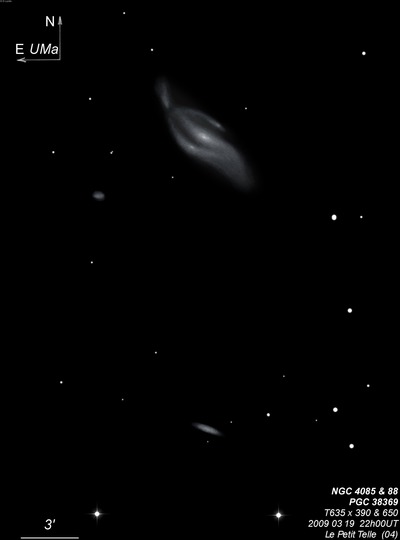
William Herschel discovered NGC 4088 = H I-206 on 9 Mar 1788 (sweep 816) and logged "cF, E, about 4' long." His summary description from 3 observations reads "cB, E, 45° np sf, 6' long, 4' br, almost equally bright." Heinrich d'Arrest made 3 observation, the earliest on 4 Dec 1861.
Sir Robert Ball, observing assistant at Birr Castle on 28 Mar 1867, recorded "vB, vL, E 53.5°. A new spiral with probably many details of interest, of an S shape. There is certainly a brighter portion sf the nucleus with a dark lane between them. Likewise, a similar brightness np the nucleus. I thought the darkness did not extend all round the centre. There can be little doubt of the curved branch following, it seems to proceed in the direction of a star nf."
200/250mm - 8" (3/28/81): fairly bright, elongated SW-NE, weak concentration, cigar-shaped. Forms a pair with NGC 4085 11' SSW.
400/500mm - 17.5" (4/13/91): bright, fairly large, elongated 5:2 SW-NE, 5.0'x2.0', mottled patchy appearance, small elongated brighter core but no nucleus. A mag 15 star is 2' off the NW side. Faint spiral structure is visible with concentration. An extremely faint arm is off the NE end curving towards a mag 14.5 star to the NE 3.7' from center and a second extremely faint arm is just visible off the SW end curving to the south. Forms a pair with NGC 4085 11' SSW.
900/1200mm - 48" (4/4/11): this is a showpiece spiral in the 48-inch with the startling eyepiece view matching the detail in the DSS image. The galaxy extended 5.5'x2.0' SW-NE. Near the center is an elongated, extremely bright core. The very bright central portion extends from the core in a roughly 2'x0.5' region towards the southwest but is concave a bit, bending slightly towards the south. This feature appears similar to a slightly distorted central bar. Just south of this central bar is a dust lane extending SW to NE that parallels the bar, though it is more contrasty to the northeast of the core.
The dust lane separates the bright bar feature from a very long arm that extends the entire length of the galaxy along the south side and vaguely emerges from the southwest end of the bar. This arm is clumpy with a couple of large, bright knots to the south of the core and another prominent knot towards the east end of the galaxy (1.7' NE of the core). Beyond this knot the arm quickly dims, fans out a bit and bends to the north towards a mag 13.5 star.
Emerging from the northeast end of the core is a second prominent arm that immediately doubles back towards the southwest on the north side. This arm nearly parallels the central bar to the north and is separated by a less contrasty darker strip or lane. This clumpy arm contains a fairly prominent knot only 0.6' NW of the core. After this point the arm dims dramatically continuing a bit further southwest. The two main arms, along with the central bar create a squashed irregular "Z" appearance.
MCG +09-20-092, which lies 5' SE in the field, appeared faint, small, round, 20" diameter, fairly low even surface brightness.
Notes by Steve Gottlieb
NGC 3359
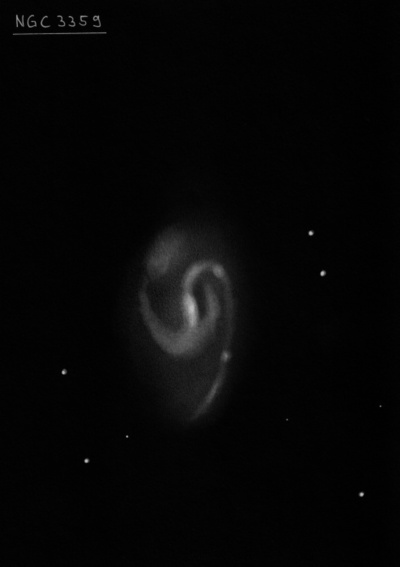
William Herschel discovered NGC 3359 = H V-52 = h745 on 28 Nov 1801 (sweep 1102) and recorded "cB, L, lE in the meridian, vgbM, about 5' long and 3' broad. The nebulosity seems to be of the milky kind [unresolvable], it loses itself imperceptibly all around. The whole breadth of the sweeps seems to be affected with vF nebulosity." His position was 3.5' too far north. On 2 Apr 1832 (sweep 411), John Herschel logged, "pF; L; E in merid; glbM; 2.5' l, 2' br."
Ralph Copeland, observing on 21 Feb 1874 at Birr Castle, made two sketches showing both a striking "S" shaped spiral and a "figure 8". No description accompanied the diagrams.
400/500mm - 17.5" (3/12/94): fairly bright, large, elongated 3:2 SSW-NNE. A brighter bar is visible through the center along the major axis! Has a large, diffuse halo about 5'x3' which fades into the background. The brighter core has an irregular surface brightness. Two mag 14 stars are 3.4' WNW and 2.8' ESE of center.
900/1200mm - 48" (2/21/12): at 375x, this beautiful barred spiral contains a prominent central bar extending ~1.3' N-S, with a bright, elongated core. A spiral arm is attached at the south end of the bar. It quickly rotates and sweeps northeast (clockwise) for 1.5', dimming out 1' E of center. A longer, beautiful arm is attached on the north end of the bar and sweeps south along the west side of the galaxy. This arm is brightest where it attaches to the bar. The western arm passes well south of the central bar and includes a couple of HII knots towards the end. The brightest is a faint 10" knot, situated 1.4' SW of center. This HII region is catalogued as [H69] 42 in Hodge's 1969 paper "HII Regions in 20 Nearby Galaxies" and as SDSS J104627.95+631220.6 (V = 16.5). It is also referenced in NED as NGC 3359:[RZB2000] #7/9, from the paper "The ionized gas in the spiral galaxy NGC 3359. Part I." in A&A, 354, 823-835 (2000). Just south of this knot the arm fades out, but brightens slightly again at the tip (2' S of center), where there is a very faint, low surface brightness knot, ~12" diameter, listed in the RZB paper as region #12/14.
Notes by Steve Gottlieb
NGC 5474
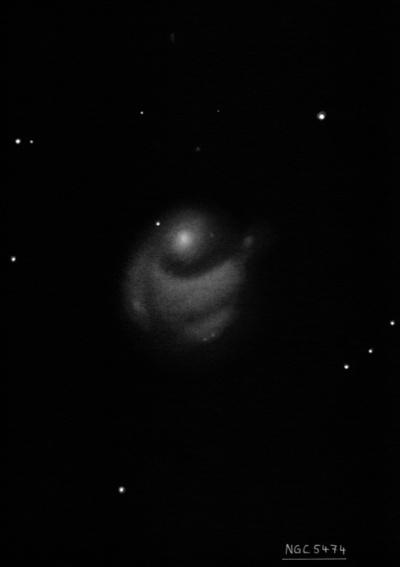
William Herschel discovered NGC 5474 = H I-214 on 1 May 1788 (sweep 840) and recorded "cB, terminating abruptly to the north, and diffused to the south." Indeed, this galaxy is very asymmetric, with the nucleus at the north edge of the galaxy!
Samuel Hunter, observing with LdR's 72" on 14 May 1861, logged "vL and probably of interest. The nucleus is on the n edge and appears to have a dark lane around it; the faint nebulosity spreads out from it like a fan with the edges rather brighter than the centre."
400/500mm - 17.5" (5/22/93): fairly bright, large, irregular round or slightly elongated SSW-NNE. Very unusual appearance as a large brighter knot of 0.8' diameter or a very eccentrically placed core is located at the NE edge. The halo extends generally SW from this brighter spot. About 3' diameter, no brightening at the geometric center. A mag 14 star is just off the NE edge 0.8' beyond knot. Located 45' SSE of M101 and the asymmetry is from being tidally deformed by M101.
900/1200mm - 48" (5/2/19): at 375x and 545x; very bright, large, highly asymmetrical galaxy. A bright core that is broadly concentrated is offset to the north end of the galaxy. A roundish 2' diameter halo extends to the south. A few faint, nearly stellar spots are on the east side of the halo. The halo was uneven in surface brightness and I had a definite impression of spiral arm structure, but was unable to trace any specific arms. This strongly "sloshed" galaxy is gravitationally distorted by interaction with M101.
Notes by Steve Gottlieb
NGC 3310
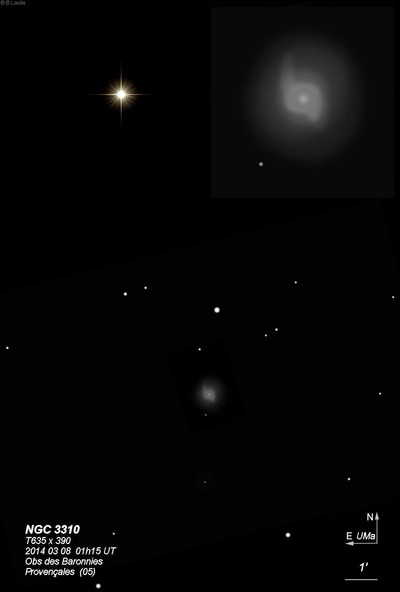
William Herschel discovered NGC 3310 = H IV-60 = h731 on 12 Apr 1789 (sweep 919) and recorded "vB, R, planetary, but very ill-defined. About 1' dia of it is equally bright, and 1/4 of a minute hazy or ill-defined round the margin." His position is accurate. On 10 Feb 1831 (sweep 324), John Herschel wrote, "B; R; vsmbM, so as to for almost a disc 15" diam. Surrounded by a very feeble atmosphere."
On 5 Mar 1848, Lord Rosse and William Rambaut observed NGC 3310 (the earliest observation in LdR's 1861 monograph) and reported, "See minute points in it at intervals, also spiral arrangement well seen." Their 11 Mar observation states, "Nebula well resolved into little stellar points. Saw a broad band across the bottom distinctly and two at the top." NGC 3310 was included in the list of nebulae exhibiting spiral structure. Later observations mentioned the possibility of this object being a cluster. A detailed observation was made on 20 Feb 1868: "Three principal branches f, nf and np towards a * np [probably a HII region]. Dark cavity on nf side. Mr De la Rue, who was with me, saw it as a bay between 2 horns, and much neby surrounding it, with many stars exterior and involved.”
400/500mm - 17.5" (1/19/91): very bright, moderately large. Unusual appearance as contains a very bright, very large central core with uniform high surface brightness with only a very faint, fairly small halo, elongated NW-SE. Located 10.4' SSW of mag 5.5 HR 4165 at the edge of the 220x field. A mag 12 star lies 3.0' N.
900/1200mm - 48" (5/16/12): extremely bright, fairly large, sharply concentrated with a large, very bright, slightly elongated N-S core, ~1' diameter. The core appears mottled with a couple of "stellarings" or small knots. The core is surrounded by a larger, much lower surface brightness irregular halo, extending the central portion to nearly 2'. An outer spiral arm is attached on the north side of the halo and was most evident near the halo. Occasionally, a very large, very low surface brightness looping arm was glimpsed, rotating 180° clockwise and ending west of the core, ~1.7' from center.
Notes by Steve Gottlieb
NGC 3718
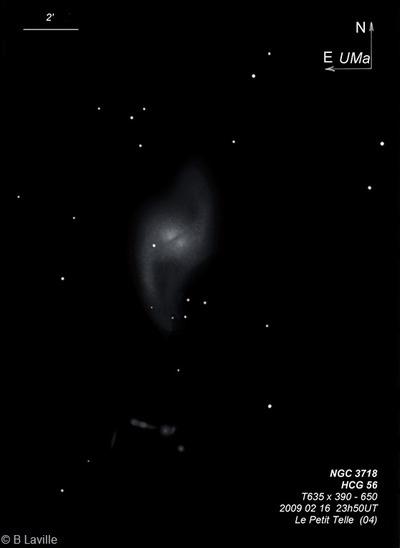
William Herschel discovered NGC 3718 = H I-221 = h908 on 12 Apr 1789 (sweep 919) and recorded "pB or cB, R, vgmbM, about 3' dia." His position is accurate.
Bindon Stoney, observing on 27 Jan 1852 with LdR's 72", commented "found a neb strongly mottled, with stars inv." A later observation in 1868 questioned if it was a double nebula.
300/350mm - 13.1" (3/24/84): fairly bright, fairly large, broad concentration, almost round. Double star h2574 = mag 11/11 at 35" separation is 2.2' SSW of center. NGC 3729 lies 12' ENE. Member of the LGG 241 or UMa NED1 group, probably a subgroup of the NGC 3992 (M109) group. The galaxy chain HCG 56 = UGC 6527 = VV 150 lies 7' S.
900/1200mm - 48" (4/4/11): NGC 3718 is a very striking, distorted system with sweeping arms emanating from an oval main body crossed by a curving dust lane (reminiscent of Centaurus A). At 375x it appeared very bright, very large, elongated ~5:2 N-S (including arms), ~6.5'x2.5', contains a bright round core. A star is at the east edge of the core. The main body is nearly split by a dust lane or gap oriented NW to SE, which is particularly evident on the NW side as a lane. A spiral arm (perhaps 0.4' wide) is attached at the NW end and gently curves counterclockwise towards the NE. The surface brightness is fairly low and the arm or wing dims as it extends nearly to the west of a mag 11 star located 4' NNE of center. The dust on the south side of the core covers a larger region and is concentrated just west of where the southern arm begins to emerge on the southeast end. A fairly low surface brightness arm spreads south (wider than the northern arm), passing east of a wide mag 11 pair at 33" separation. The overall visual impression is that the "arms" are really tidal tails being drawn out from a past interaction as the central body looks more like the merger of two galaxies resulting in the warped dust lane and "S" shaped body. All five members of HCG 56 (located 7' S) were easily resolved.
Notes by Steve Gottlieb
NGC 4096
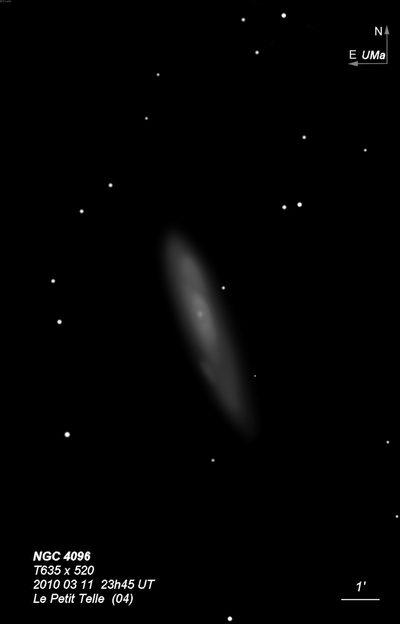
William Herschel discovered NGC 4096 = H I-207 = h1081 on 9 Mar 1788 (sweep 816) and reported "cF, mE about 4' long from sp to nf but nearer the meridian." On 10 Apr 1788 (sweep 830) he recorded "cB; mE; 6 or 7' long, from sp to nf, about 70°." In his 1811 PT paper, WH commented "it seems to join to imperceptible nebulosity on the south preceding side." The galaxy does extend further out and more gradually fade on the southwest side. On 8 Mar 1831 (sweep 330), John Herschel logged, "B; vL; mE in pos 32°; seen through much fog." His position is accurate.
400/500mm - 17.5" (4/7/89): bright, very large, almost edge-on 4:1 SW-NE, sharp concentration with a very small bright core embedded within the long extensions. Member of the CVn II Group (brightest member M106).
Notes by Steve Gottlieb
NGC 3079
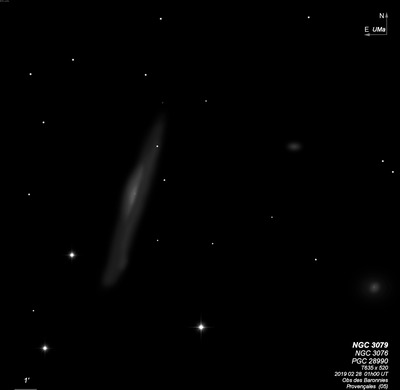
William Herschel discovered NGC 3079 = H V-47, along with NGC 3073, on 1 Apr 1790 (sweep 955) and recorded "cB or vB, mE from np to sf, about 8' l and 2' br, vgmbM." His position is accurate.
400/500mm - 17.5" (3/12/88): very bright, large, edge-on 6:1 NNW-SSE, bright core. Forms a trio with NGC 3073 10' WSW and MCG +09-17-009 6' NW (noted as "very faint, very small, round.") To the south is a triangle of bright stars; mag 9.0 SAO 27486 7' SE, mag 8.3 SAO 27476 6' SSW and mag 9.1 SAO 27482 3.3' SE of center.
900/1200mm - 48" (4/18/15): I made another short observation of this remarkable asymmetric edge-on at 375x and 488x before observing the Twin Quasars, which lie 14' NNW. The brightest portions of this 6:1 edge-on NNW-SSE is warped and bowed out towards the east in the very bright central section. An intense nucleus is within this central section, though offset to the east of center. The west side of the central section is irregular in surface brightness due to dust. The northern extention thins and has a slight bend on the north end, beyond a mag 14 star. On the south side is a bright streak, but to the east of this streak and further south the galaxy is dusty and sections of the galaxy appear to be highly obscured. Two mag 14 stars are off the west side of the galaxy and mag 9.6 HD 237858 is 3.5' SE of center.
Both components of the Twin Quasars at mag 16.7 and 16.9 were easily visible nearly continuously at 697x. The southern component was clearly slightly brighter, although the delta mag is only 0.2. At 6" separation, the pair was relatively widely split.
48" (4/6/13): I only took a quick look at this gorgeous showpiece edge-on at 375x. The entire length of the galaxy appeared very mottled, clumpy and dusty, although there was no distinct dust lane. The shape is irregular and sharply rises to an intense, very elongated 4:1 core that bulges and appears offset from the geometric center. A mag 14 star is superimposed on the north side and SDSS J100200.73+554247.0, an extremely faint galaxy (V = 18.6), was glimpsed 1.2' E.
Notes by Steve Gottlieb
NGC 3945
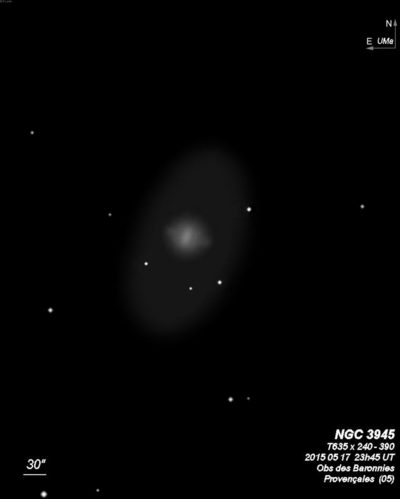
William Herschel discovered NGC 3945 = H I-251 = h1006 on 19 Mar 1790 (sweep 953) and recorded "vB, perfectly R, BN with F chevelure joining to it by imperceptible degrees; the whole about 1 1/2' dia. CH's reduced position is 16 tsec of RA too small. JH made two observations and logged on sweep 344 "B; R; psbM; 60"; a star precedes 8 sec of time from neb in PA 215.9°."
400/500mm - 17.5" (4/13/91): bright, fairly small, slightly elongated, 2.0'x1.5'. The small, very bright core has sharp edges and appears mottled with bright spots. The slightly elongated halo is much fainter. Three stars are near; a mag 12 star is 1.3' SW and two mag 13.5 star lie 1.7' NW and 1.3' S.
Notes by Steve Gottlieb
NGC 3319
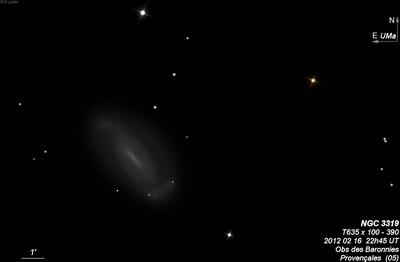
William Herschel discovered NGC 3319 = H III-700 on 3 Feb 1788 (sweep 804) and recorded "cF, L, irr E, about 4' long and 2 1/2' br, much brighter south of the middle." CH's reduction is just off the southeast side of UGC 5789.
400/500mm - 17.5" (2/8/91): fairly faint, very elongated 5:2 SW-NE. The brightest portion is a large bar with a knotty extension attached at the SW end and extending on a right angle to the south. At this position on the POSS are several bright knots.
900/1200mm - 48" (5/1/19): at 488x; very large barred spiral, extending 2:1 SW-NE and ~5.5' along the major axis! The galaxy is sharply concentrated with a very bright, very elongated high contrast bar, extending 1' SSW-NNE! A fairly easy section of a spiral arm parallels the bar on the south side of the galaxy. A couple of easy knots, ~6" and 10" in size, along with a faint star, are at the SW end of this arm [1.9' SSW of center]. The arm vaguely bends at a right angle to the NW and contains a bright, 12" knot [V = 16.6] . A low contrast arm is west of the bar, also running parallel (SSW-NNE). Another low surface brightness arm is NE of the bar. It curls sharply counterclockwise to the east and occasionally contained an extremely faint HII knot. An ill-defined, diffuse glow (part of this arm) extends further northeast to the outer edge of the halo. SQM 21.85.
Notes by Steve Gottlieb
NGC 3583
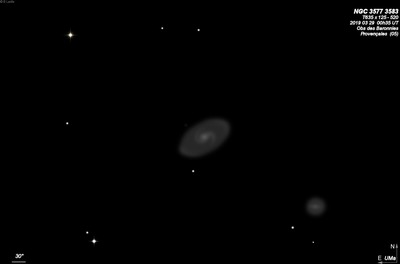
William Herschel discovered NGC 3583 = H II-728 on 5 Feb 1788 (sweep 808) and recorded "pB, pL, R, vgmbM." His position on sweep is 4' north of UGC 6263 (similar offset as NGC 3577 = II-723 on sweep 822).
400/500mm - 17.5" (4/6/91): fairly bright, fairly small, elongated 3:2 WNW-ESE, 1.5'x1.0', bright core, stellar nucleus at moments. A mag 14 star is just off the south side 1.5' from the center. Forms a pair with NGC 3577 5.2' SW.
Notes by Steve Gottlieb
NGC 4013
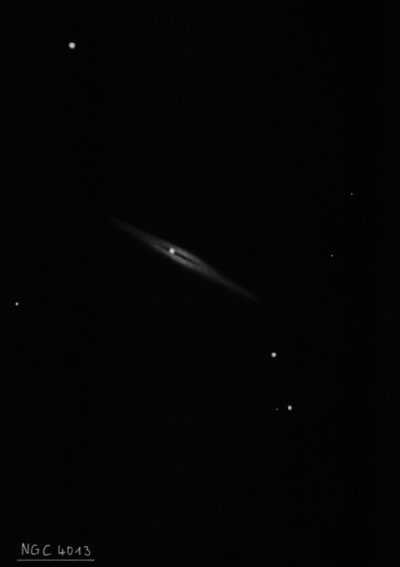
William Herschel discovered NGC 4013 = H II-733 = h1041 on 6 Feb 1788 (sweep 810) and recorded "pB, mE, about 4' long and 3/4' br. A pBSN and vF branches near the meridian." JH made two observations and logged on sweep 248 "B; mE; vsvmbM to a * = 10-11m; pos of extension = 62.3° by measure."
George Stoney, LdR's assistant, recorded it on 17 Mar 1849 as "E with a split or opening in the direction of major axis and a star a little following the center." The dark lane was confirmed on 12 Apr 1861: "Brightest part preceding the star and certainly a narrow split going towards preceding end from the star."
400/500mm - 17.5" (3/8/97): moderately bright, fairly large edge-on 5:1 WSW-ENE, 3.5'x0.7'. A mag 12 star is superimposed very close to the actual center and masquerades as a bright stellar nucleus (similar to M108). The galaxy bulges towards center but is only weakly concentrated, fades towards tips. On the DSS the star is superimposed on a thin equatorial dust lane that was not seen. Member of the NGC 4111 group in the UMa cloud.
Notes by Steve Gottlieb
NGC 4100
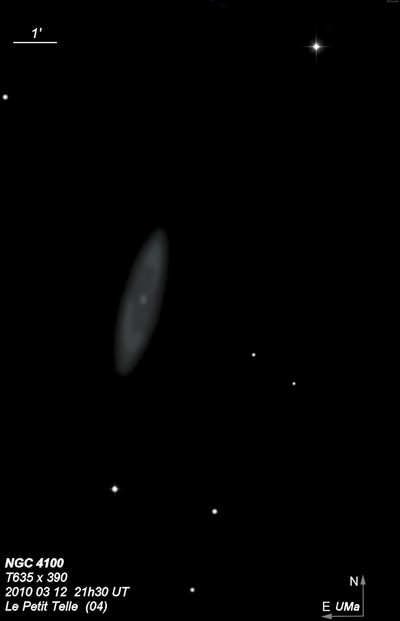
William Herschel discovered NGC 4100 = H III-717 = h1084 on 9 Mar 1788 (sweep 816) and logged cF, mE about 5' long near the meridian [N-S], about a little sf." Caroline's reduction is 1.3' northeast of center. John Herschel made two observations, recording on 7 Mar 1831 (sweep 329), "pB; vL; mE in pos 166.5°; 3' long, 1' broad, vgvlbM. This cannot be either [NGC 4088] nor [NGC 4096], as neither of these agrees in its angles of position."
400/500mm - 17.5" (5/2/92): bright, very large, very elongated 3:1 NNW-SSE, 4.0'x1.5', large brighter core, faint stellar nucleus. The northern extension appears slightly brighter. Mag 8.2 SAO 44027 is 7' NW. Member of the M109 (NGC 3992) group = LGG 258.
Notes by Steve Gottlieb
NGC 4102
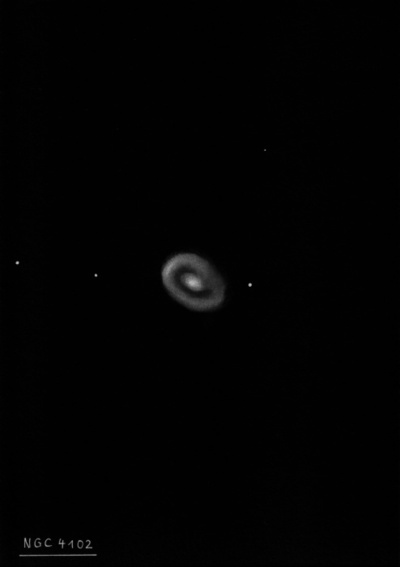
William Herschel discovered NGC 4102 = H I-225 = h1085 on 12 Apr 1789 (sweep 919) and noted "pB, pL." JH recorded "B; R; psbM; has a * 12m 35" sp, very near the edge." and measured an accurate position.
Bindon Stoney, Lord Rosse's assistant, noted on 13 Apr 1852, "I suspect a dark curved passage south of center, probably a new spiral." Four years later R.J. Mitchell confirmed "I have little doubt this is a spiral" and he made two diagrams of the arm arrangement.
400/500mm - 17.5" (5/13/88): fairly bright, moderately large, oval 3:2 SW-NE, small very bright core, stellar nucleus. A mag 12.5 star is at the west end 48" from the center!
900/1200mm - 48" (4/20/17): at 488x; fascinating galaxy with unusual structure. Overall, NGC 4102 is very bright, large, elongated at least 2:1 SSW-NNE, ~2.5'x1.1', very sharply concentrated with a small, intensely bright nucleus surrounded by a bright oval core SW-NE with a bar-like enhancement. Just outside the core the surface brightness drops significantly forming a darker [dusty] annulus. Surrounding this is a bright, thick, mottled ring oriented NNW-SSE (slightly offset in orientation from the core). A brighter knot (SDSS J120625.26+524307.4) is at the NE end of the ring [32" NE of center]. On the SDSS this corresponds with the brightest star cloud in the galaxy and the site of supernova 1975E. A brighter mag 12.5 star is 50" WSW of center, just outside the halo. When the seeing settled this star resolved into a close pair (~13.2/13.8 at 1.8" separation!) NGC 4068 lies 23' WSW. Member of the M109 (NGC 3992) group = LGG 258.
Notes by Steve Gottlieb
NGC 3690
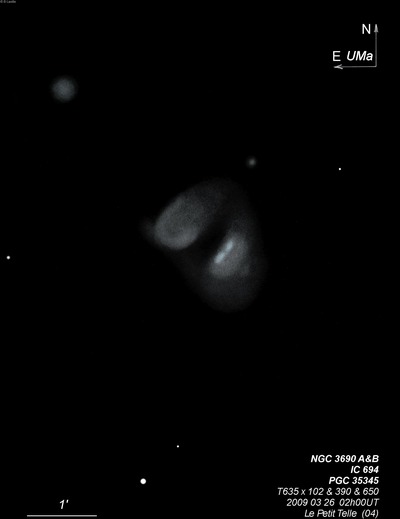
William Herschel discovered NGC 3690 = H I-247 = h896 on 18 Mar 1790 (sweep 951) and recorded "pB, lE, mbM." On 9 Apr 1793 (sweep 1039) he logged "vB, pL, lE near the parallel, but a little from nf to sp." JH reported "B; R; pgbM. Query whether there be not a * excentric towards the south-following side." The "star" may refer to the companion on the south side. On 27 Jan 1852, LdR's assistant Bindon Stoney described the system as "Neb div into two parts, faint appendage np about one dia distant."
Swift also noticed it was double in 1883, writing in Sidereal Messenger IV (p39), "mentioned to all observers as very little elongated. Chancing to run across it with a power of 132, I immediately suspected it to be a close double, which suspicion a power of 200 confirmed. It is probably the closest double nebula known." Swift reobserved the galaxy on 18 Apr 1892 (list X) and noted "vs, close D with [NGC] 3690, suspected with 132, ver with 200". This is nearly identical to his 1883 comments. Dreyer entered Stoney's and Swift's second component as IC 694 -- but did they apply to the same object?
Usually, IC 694 is identified as the southwest component of the interacting double system NGC 3690 and this is likely what Swift resolved in his first observation. But Stoney's earlier observation clearly resolved NGC 3690 into two components as well as picking up the extremely faint 16th mag galaxy (MCG +10-17-002a = VV 118c) "one diameter" NW of the NGC 3690 system. Based on Stoney's observation, it is reasonable to assign IC 694 or IC 694B to MCG +10-17-002a = VV 118c.
400/500mm - 17.5" (4/1/95): NGC 3690 is a disrupted, interacting double system (Arp 299). This unusual pair appears moderately bright, fairly small, elongated E-W. The appearance is confusing with two very small "knots" in a common halo elongated E-W (20" between centers). On the west side is a fairly bright virtually stellar "knot", which is probably the nucleus of the brighter member of NGC 3690. There is a small fainter unconcentrated extension on the following end and the two components are not individually resolved. With averted vision, IC 694 was barely glimpsed as an extremely faint spot about 1' NW.
17.5" (3/19/88): fairly bright, moderately large, elongated ~E-W, irregular, mottled appearance. A mag 14 star is superimposed on the west side and an extremely faint mag 15.5 star or knot is involved. This is a disrupted interacting system which includes IC 694.
900/1200mm - 48" (5/12/12): at 488x, the southwest component (VV 118b) of NGC 3690 appeared as a very bright, elongated, irregular knot of high surface brightness. Contains a very bright, quasi-stellar nucleus. The northeast component (VV 118a) is the larger of the merged interacting pair and appeared bright, moderately large, ~1' diameter, small very bright core. A very low surface, asymmetric halo extends on the northwest side of the bright pair. The southwest component is generally misidentified as IC 694, which is described below.
VV 118d/e, probably HII regions, are just 45" NW of NGC 3690 (just outside the halo). Occasionally an extremely faint and small glow popped in this position, 6"-8" diameter. IC 694, ~1' NW of the bright pair, was easily visible as a fairly faint, slightly elongated glow, 15"x12", weak concentration. PGC 35345 (the brighter component of Arp 296) lies 2.6' NE. It was also a direct vision, fairly faint glow, fairly small, oval 4:3 NW-SE, 24"x18", increasing to a very small brighter core.
Notes by Steve Gottlieb
NGC 5204
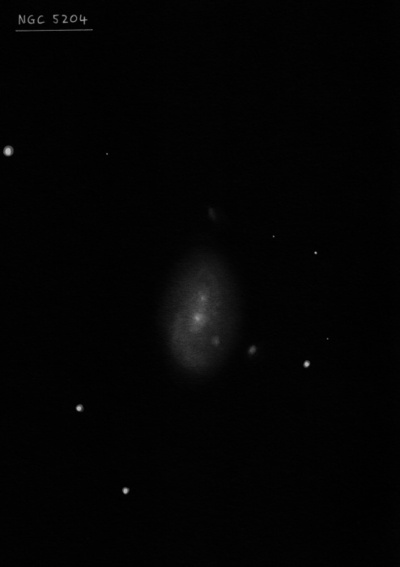
William Herschel discovered NGC 5204 = H IV-63 = h1625 on 24 Apr 1789 (sweep 926) and recorded "cB, cL, vgmbM, easily res. I suppose with a higher power I might have seen the stars." His position was poor -- 35 seconds of RA east of UGC 8490. John Herschel made a single observation and noted "pB; irreg R; gbM; 90"; r; no nucleus seen." His RA was 8 seconds too small. Edward Fath commented that NGC 5204 may be UGC 8490 (No. 627 in Table 1) in his 1914 paper "A Study of Nebulae". He remarked it was "irregular with a number of condensations", based on a plate taken with the Mt Wilson 60-inch.
Charles E. Burton, the Birr Castle observer on 23 Apr 1868, recorded "E ns, dark lane np sf on north side of nucleus. Suspect a spiral branch on np side extending to a star sp. Two stars sf, is the following of the 2 nebulous?"
200/250mm - 8" (4/24/82): faint, moderately large, diffuse, elongated N-S.
400/500mm - 17.5" (6/3/00): moderately bright, elongated 4:3 N-S, 3.5'x2.5', weak concentration. Has a mottled appearance with several slightly brighter knots across the face of the galaxy [on the DSS, the galaxy is quite unusual with numerous knots]. The outer halo fades into the background. A nice fairly bright double star is near the edge of the field. Member of the M101 group.
600/800mm - 24" (6/12/18): fairly bright, fairly large, oval N-S, ~3.5'x2.5', irregular halo, broad concentration to a large, very ill-defined central region but no nucleus. The surface brightness is notably irregular or mottled due to numerous blue compact HII regions, but no individual regions were resolved on the face of the galaxy.
Notes by Steve Gottlieb
NGC 2685
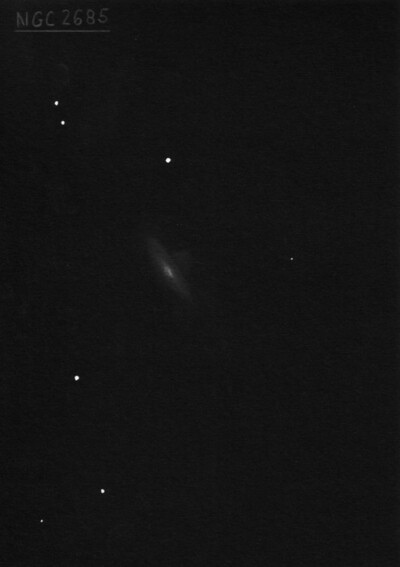
Wilhelm Tempel discovered NGC 2685 = T VI-8 on 18 Aug 1882 with the 11" refractor at the Arcetri Observatory. His position is ~30 sec of RA too far east and 3' too far north, but the identification is certain.
300/350mm - 13.1" (1/18/85): moderately bright, fairly small edge-on 4:1 SW-NE. Contains an elongated bright core. A mag 11 star is 2.4' N of center. The well-known polar ring was not seen.
900/1200mm - 48" (4/6/13): this famous polar-ring galaxy (nearest and brightest) was viewed at 488x. It appeared very bright, large, very elongated 3:1 SW-NE, 1.5'x0.5', slightly bulging center (spindle shape), high surface brightness and brighter along the central axis. Well concentrated with an intense core and surrounded by a much larger, low surface brightness halo that increases the size to 2.5'x1.2'. The polar-ring was seen on the northwest side as a faint, low surface brightness outer loop attached to the spindle and bulging out ~20". Periodically the outer edge of the loop popped as a distinct arc and appeared as a semi-ring. A mag 11 star lies 2.4' N.
Notes by Steve Gottlieb
NGC 5308
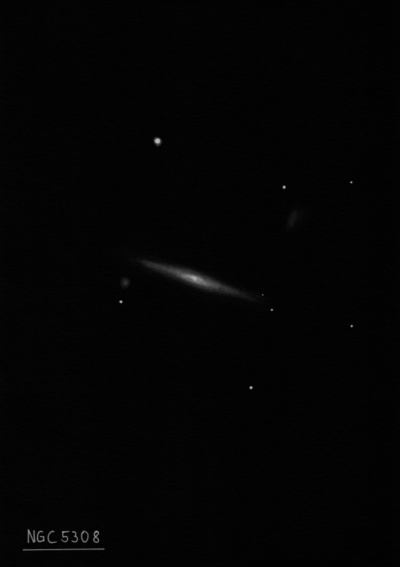
William Herschel discovered NGC 5308 = H I-255 = h1674 on 19 Mar 1790 (sweep 953) and logged "vB, mE, 3' l and 1/2' br, BENM." JH recorded "pB; S; mE in pos 57.4° by micrometer; psbM; 30" l." and measured an accurate position.
400/500mm - 17.5" (5/30/92): bright, fairly small, almost edge-on 4:1 SW-NE, 1.8'x0.4', very small very bright core, unusually bright stellar nucleus or almost stellar nucleus. Appears as a pretty streak with a high surface brightness core.
Notes by Steve Gottlieb
NGC 3729
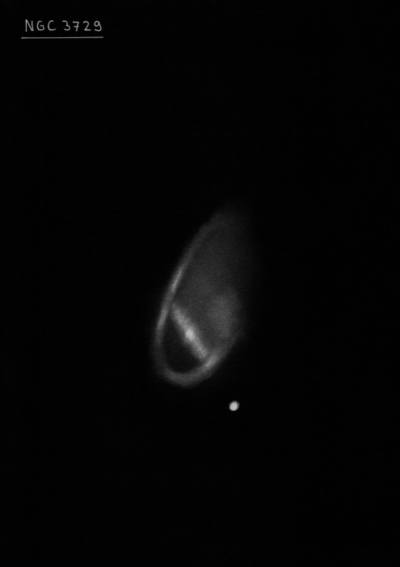
William Herschel discovered NGC 3729 = H I-222 = h911 on 12 Apr 1789 (sweep 919) and recorded "pB, iE, gbM, nearly in the meridian, about 2' long. JH called this galaxy "Not B; L; lE; a *12 mag south-preceding very near the edge." His position is accurate.
Bindon Stoney, observing on 27 Jan 1852 with LdR's 72", commented "12' following [NGC 3718] is another neb, irr, with a bright star in south edge and having dark lanes through it."
300/350mm - 13.1" (3/24/84): fairly bright, fairly small, elongated ~N-S. A mag 11 star is on the SSW edge 57" from the center. NGC 3718 lies 12' WSW. Member of the LGG 241 or UMa NED1 group, a subgroup of the M109 Group
Notes by Steve Gottlieb
NGC 4144
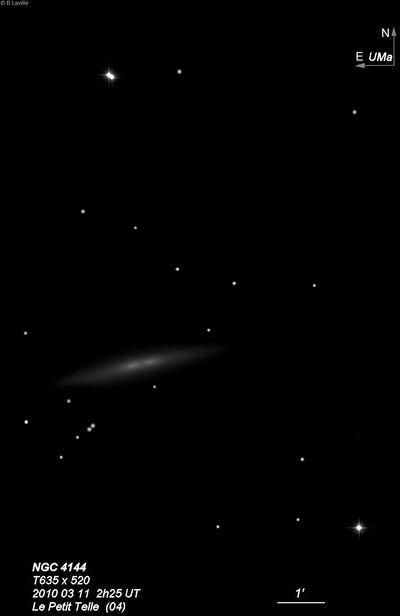
William Herschel discovered NGC 4144 = H II-747 = h1107 on 10 Apr 1788 (sweep 830) and recorded "pB, E, about 3' long, from np to sf about 15 or 20°." John Herschel made two observations, logging on 26 Apr 1830 (sweep 255), "F; vmE in pos 109° by meaure; vgvbM; 4' long, 30 or 40" br."
200/250mm - 8" faint, edge-on WNW-ESE.
400/500mm - 17.5" (4/7/89): fairly bright, very large, edge-on 5:1 WNW-ESE, 5'x1', bright core. Double star mag 13.5/13.5 at 8" separation is off the SE end 2.3' from center. Located between two mag 9 stars 8' N (double) and SAO 44057 7.7' SW. Member of the M94 Group (CVn I Cloud) or possibly the CVn II Group (brightest member M106).
Notes by Steve Gottlieb
NGC 3448
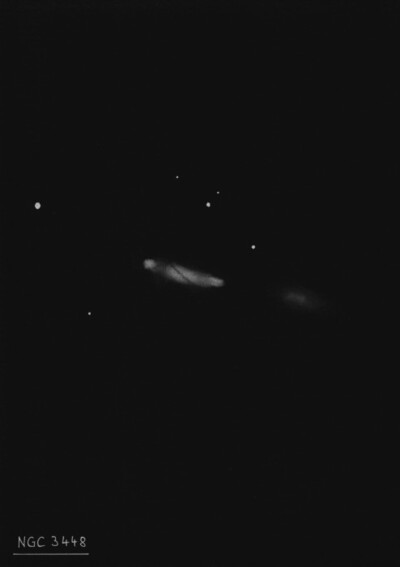
William Herschel discovered NGC 3448 = H I-233 = h788 on 17 Apr 1789 (sweep 922) and logged "vF, L, E 20° sp to nf, r." On 10 Feb 1831 (sweep 324), John Herschel wrote,"B; mE; gbM; no nucl; 1 3/4' l, 20" br; pos = 67°."
R.J. Mitchell, observing on 8 Mar 1856 at Birr Castle, recorded "mE, certainly dark spaces on each side of the nucleus, but not well seen; the foll one rather more distinct. A sketch or diagram matches the photographic appearance with brighter knots at each ends of the extensions.
400/500mm - 17.5" (3/12/88): fairly bright, moderately large, very elongated 3:1 WSW-ENE, halo increases to a small bright core. A mag 13.5 star follows 3.1' from center. An extremely faint knot is visible east of the core along the major axis about 35" from the center. Located 19' SE of 44 Ursa Majoris (V = 5.1).
900/1200mm - 48" (5/16/12): this interacting starburst galaxy appeared very bright, large, very elongated 3:1 WSW-ENE, high surface brightness, irregular shape, mottled appearance. At the northeast end of the galaxy is a large, bright knot, ~25"x12", which is possibly the disrupted core of the galaxy. Occasionally an extremely faint tidal tail could be glimpsed, extending perhaps 1.5' ENE. The beginning of the tail near the bright knot was easily seen. At the very tip was a marginally visible galaxy, perhaps glimpsed a couple of times. The dim tail extends the length from 2.4' to 3.6'.
NGC 3448 is interacting with UGC 6016, a low surface brightness dwarf galaxy, 4.1' WSW. The companion appeared as a faint to fairly faint, low surface brightness patch, elongated SW-NE (in the direction of NGC 3448) , ~1.2'x0.5', no concentration.
Notes by Steve Gottlieb
NGC 3738
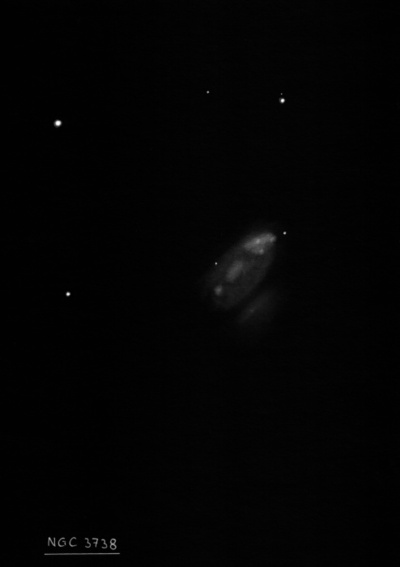
William Herschel discovered NGC 3738 = H II-783 on 14 Apr 1789 (sweep 920) and recorded "pB, pL, bM." His position matches UGC 6565.
300/350mm - 13.1" (3/24/84): fairly bright, almost even surface brightness.
400/500mm - 17.5" (3/19/88): fairly bright, moderately large, elongated 3:2 NNW-SSE although has an irregular appearance. Sharper edge on the west side and more curved on the east side. Two mag 10/11 stars are 2.4' NE and 4.0' ENE of center. NGC 3756 lies 15' SE.
600/800mm - 24" (5/27/17): at 200x; bright, large, elongated 3:2 NNW-SSE, ~2.0'x1.3', noticeably mottled or knotty appearance. Broad concentration but no defined core or nucleus. A brighter knot (HII complex?) is on the northwest side. A chain of bright stars begins at a mag 10.5 star 2.5' NE of center and extends southeast. NGC 3756 is 16' SE.
Notes by Steve Gottlieb
NGC 3769
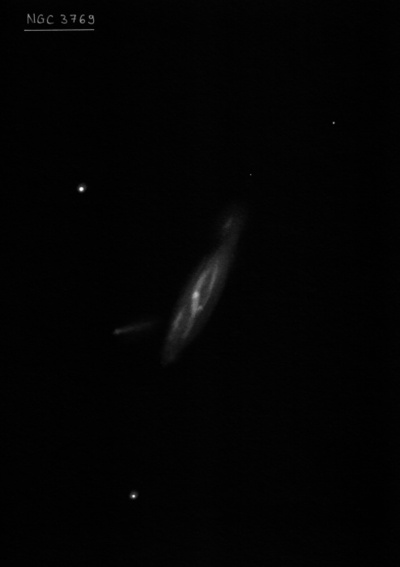
William Herschel discovered NGC 3769 = H II-731 = h925 on 5 Feb 1788 (sweep 808) and reported "F, S, E from sp to np." JH made two observations, recording on sweep 330 "'B; mE; gbM; 60" l, 30" br."
Neither Herschel noticed the faint companion NGC 3769A at the southeast end, which was observed at Birr Castle. On 9 Apr 1852, Bindon Stoney recorded "gbM, a F appendage of 2nd neb." On 17 Apr 1855, R.J. Mitchell logged "The appendage looks like an independent nebula. Lord Rosse thought the B ray resolvable." On 12 Apr 1861, Samuel Hunter also noted "Two, probably connected." A sketch shows the companion at the correct orientation. But surprisingly, neither JH nor Dreyer added this second galaxy to the GC or NGC. Kobold measured an accurate position in 1902 with the 18-inch refractor at Strasbourg.
400/500mm - 17.5" (4/6/91): fairly bright, moderately large, very elongated 3:1 NNW-SSE, 2.5x0.8', weak concentration. A mag 13.5 star is 2.2' NE of center. A very close companion NGC 3769A = CGCG 242-066, which appeared very faint, very elongated 3:1 WNW-ESE, low surface brightness, is 56" SE of center.
Notes by Steve Gottlieb
NGC 3027
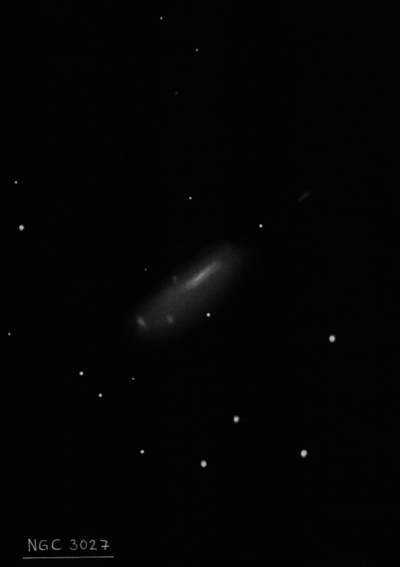
William Herschel discovered NGC 3027 = H V-23 = h643 on 3 Apr 1785 (sweep 390) and logged "F, L, lE, resolvable, 6' or 7' l, 5' or 6' br." His position was just off the east side of UGC 5316. John Herschel recorded this object on 4 Nov 1831 (sweep 382) as "eF; vL; vglbM; 3' l; 2.5' br."
400/500mm - 17.5" (4/4/92): faint, fairly large, elongated NW-SE, 3'x2', weak concentration, low surface brightness. Two mag 15 stars are superimposed at the NW end of the major axis and at the south edge. NGC 2985 lies 25' WNW.
Notes by Steve Gottlieb
NGC 5430
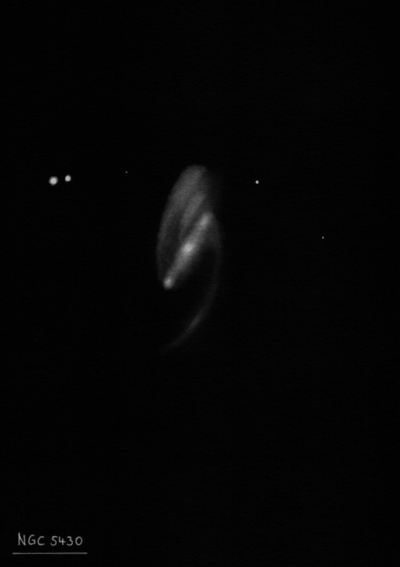
William Herschel discovered NGC 5430 = H II-827 = h1738 on 17 Mar 1790 (sweep 948) and logged "eF, S, E, but nearly R." CH's reduced position is 3' north of UGC 8937. JH measured an accurate position on a single observation.
200/250mm - 8" (4/24/82): faint, small, round. Located southeast of NGC 5376 and NGC 5389.
400/500mm - 17.5" (6/7/97): fairly faint, fairly small, elongated ~2:1 NNW-SSE, brighter core containing a stellar nucleus. A mag 14-15 "star" is involved at the south-southeast end. This "star" may confuse the apparent position angle of the galaxy as the major axis (including halo) is N-S. A faint pair of mag 14.5 stars follows by 2.0'.
The stellar object at the south-southeast end is a strong HII emission knot (Ho 569b = Mrk 799a) thought to contain a large number of type-O and Wolf-Rayet stars.
17.5" (4/5/97): moderately bright and large, elongated 5:2 NNW-SSE, 2.0'x0.8', brighter core increases to an occasional stellar nucleus. A mag 15 "star" is close southeast and a mag 14.5 pair at 12" separation lies 2.0' ENE of center.
600/800mm - 24" (7/1/16): at 375x; moderately to fairly bright, elongated 5:2 NNW-SSE, ~2'x0.8', contains a small bright elongated core (bar). The surface brightness in irregular with some interesting structure. I had an impression of a spiral arm extending north on the east side of the halo.
A fairly faint nonstellar knot (Holm 569B), 6"-8" diameter, is at the southeast end of the bar [21" from center]. There is a small dip in brightness between the central region and the knot. Bill Keel considered the knot an extremely luminous HII region, but a recent paper assumes NGC 5430 is a minor merger and the "knot" is an off-center dwarf satellite with a triggered star formation.
Notes by Steve Gottlieb
NGC 3656
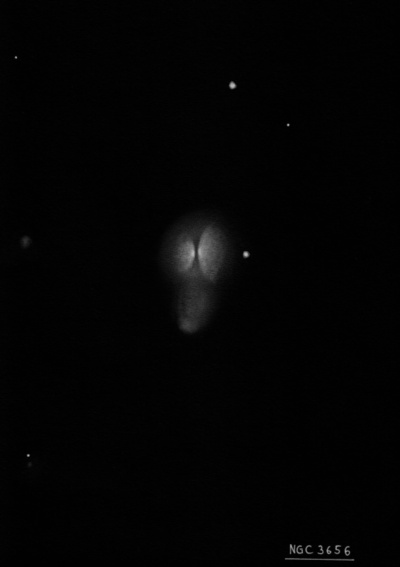
William Herschel discovered NGC 3656 = H II-782 = h874 on 14 Apr 1789 (sweep 920) and recorded "pB, S, R, vgmbM, just following a small star." JH logged "pB; R; vglbM; 20"; a * 12m preceding." and measured a very accurate position.
400/500mm - 18" (5/30/03): moderately bright, round, fairly small, 0.8' diameter, fairly weak concentration with a brighter core. A mag 12 star is just off the west side, 45" from center.
900/1200mm - 48" (4/6/13): bright, moderately large, irregularly round, ~1.3'x1.0', large very bright core but no distinct nucleus. A mag 12.7 star is just off the west edge of a large, diffuse halo. A dust lane or absorption patch is evident on the north side as a region of lower surface brightness.
MCG +09-19-64, a merging companion, is attached at the southern edge of the halo [40" S of center]. It appeared faint, fairly small, low surface brightness, slightly elongated E-W, 20"x15". PGC 2452556, 2.3' ENE, was a fairly faint, fairly small, roundish glow, 15" diameter, with a brighter core.
Notes by Steve Gottlieb
NGC 3786
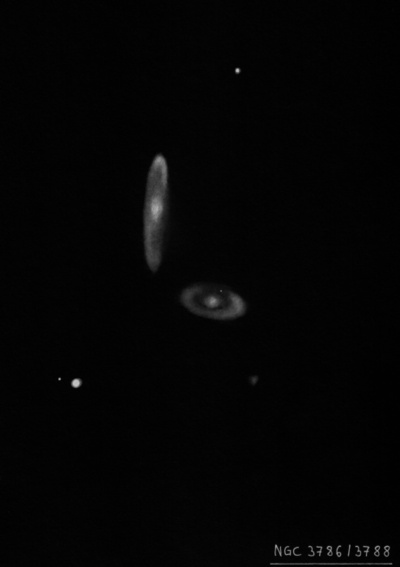
John Herschel discovered NGC 3786 = h931 on 29 Apr 1827, along with NGC 3788, and logged "the sp of 2 [with NGC 3788]; less bright and smaller than the nf." He made 3 observations of both galaxies.
400/500mm - 17.5" (2/24/90): moderately bright, moderately large, elongated 5:2 WSW-ENE, bright core. Forms a pleasing close pair with NGC 3788 (separation of 1.4' NE). The galaxies are elongated at nearly right angles and almost attached at the ENE end of NGC 3786. A mag 10.5 star is 2' SE.
600/800mm - 24" (6/16/20): moderately to fairly bright, moderately large, oval 2:1 WSW-ENE, 1.0'x0.5', bright core, small bright nucleus. Forms a striking pair (Arp 294 = VV 228) with NGC 3788 1.4' NNE.
Notes by Steve Gottlieb
NGC 3921
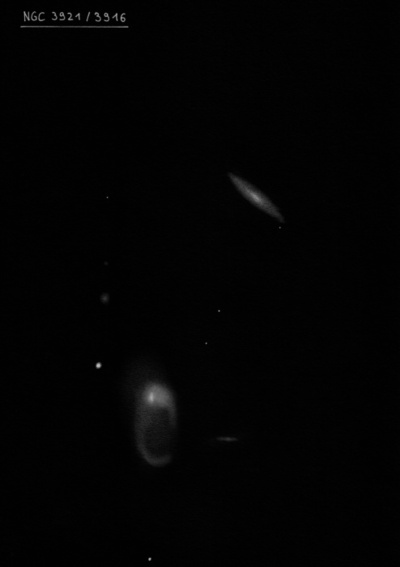
William Herschel discovered NGC 3921 = H II-788 = h997 on 14 Apr 1789 (sweep 920) and recorded "Two, the south-following [NGC 3921], which is that of which the place is taken, is pB, S [with another [NGC 3916] north-preceding about 5', it precedes the other about 5 sec in time.)" JH logged "pB; R; psbM" and measured an accurate position. The RA in the RNGC is 0.5 min too large.
400/500mm - 17.5" (3/19/88): fairly faint, small, round, small very bright core. Brightest of three with NGC 3916 4.5' NNW and MCG +09-19-213 5' W.
900/1200mm - 48" (5/12/12): at 488x; the "core" of this disrupted galaxy is very bright, oval 4:3 N-3, ~25"x20", fairly sharply concentrated with a small intense nucleus that brightens to a blazing stellar center. A large, faint tear-drop shaped plume extends from the core 1' due south. The plume forms an elongated loop or ring with a brighter rim. The offset, brilliant core sits at the north edge of the loop.
PGC 2489542 lies 1.2' SW and appeared faint, very small, elongated 2:1 E-W, ~12"x6". PGC 2491113 is 2.4' NNE and was fairly faint, very small, slightly elongated, 12"x9". These two fainter galaxies are captured in Arp's 200-inch photo. Also nearby are MCG +09-19-213 5' WSW and NGC 3916 5' NW. NGC 3921 is considered a proto-typical late stage merger-remnant with two long, crossed tidal tails indicating a merger of two former disk galaxies.
Notes by Steve Gottlieb
NGC 3995
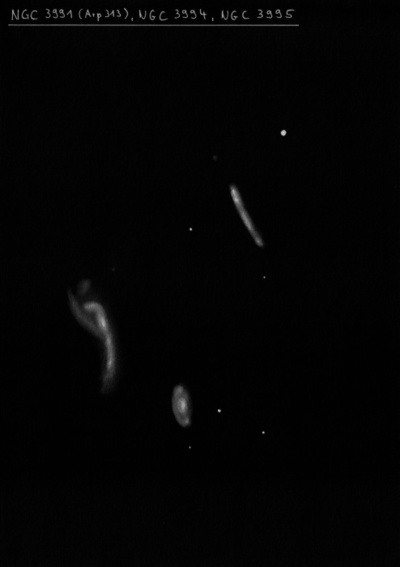
Heinrich d'Arrest discovered NGC 3995, along with NGC 3991, on 5 Feb 1864. His position, measured on 3 nights, is accurate.
400/500mm - 17.5" (2/24/90): moderately bright, moderately large, elongated 5:2 SW-NE, large bright core. Third and largest of an excellent trio with NGC 3994 1.8' SW and NGC 3991 3.8' NW. Located 6.6' W of mag 6.4 SAO 62774.
600/800mm - 24" (5/25/14): fairly bright striking galaxy with unusual asymmetric structure, fairly large, elongated roughly 5:2 SSW-NNE, well concentrated with a very bright core containing a short bar oriented E-W. A long linear arm is attached at the west side of the core and extends south ~40". The outer, western edge of this arm has a sharply defined edge and the inner (eastern) side has a low, irregular surface brightness. A short extension (arm) heads northeast from the east side of the core. As a result the core appears offset towards the north, because of the longer southern arm. Mag 6.4 HD 103928 lies 5' ESE and was placed outside the field.
Notes by Steve Gottlieb
NGC 4194
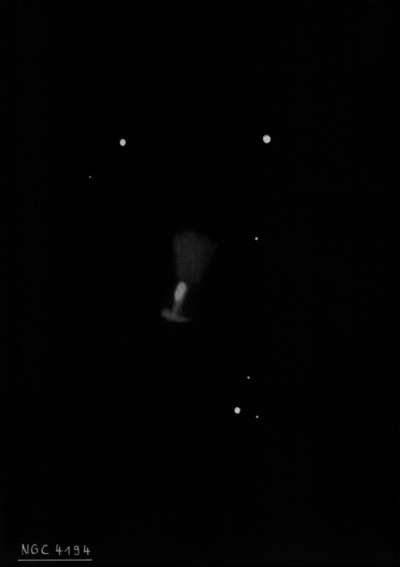
William Herschel discovered NGC 4194 = H II-867 = h1135 on 2 Apr 1791 (sweep 1001) amd noted "pB, vS, stellar." JH called it "F; vsmbM to a * 12m; 20"." His position is at the northwest edge of the galaxy.
The nickname Medusa Galaxy was coined by V-V in his Atlas of Interacting Galaxies, Part II: "Of this 'Medusa', the structure of the "head" is as yet unresolved. In this case, three galaxies apparently are coalescent. "Behind", the dwarfs begin to separate." William Keel repeats the nickname "Medusa" in his April 1993 article "The real astrophysical zoo - Colliding galaxies" in Mercury (ASP). Professional journal papers refer to it as "Medusa" since 2000.
400/500mm - 17.5" (5/13/88): moderately bright, small, elongated NW-SE, very small bright core, stellar nucleus.
900/1200mm - 48" (4/20/17): at 697x; bright, fairly large, elongated ~2:1 NNW-SSE. Sharply concentrated with a very bright elongated core enclosing an intensely bright nucleus. The main halo is roughly oval with a weak, elongated brightening oriented SW-NW at the south end. This low contrast feature is possibly the remnant of a past merger. A very low surface brightness tidal plume was seen as an ill-defined haze spreading out to the north from the NNW side of the main halo and increasing the N-S dimension to over 1.5'.
Notes by Steve Gottlieb
NGC 3445
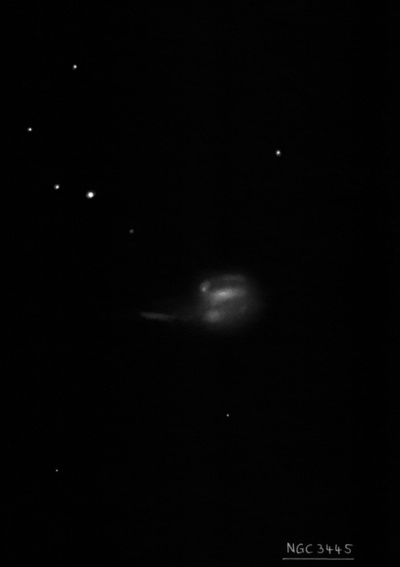
William Herschel discovered NGC 3445 = H I-267 = h787 on 8 Apr 1793 (sweep 1038) and recorded "cB, pL, iR, about 1 1/4' dia. The greatest part of it almost equally bright." On 9 Feb 1831 (sweep 323), John Herschel wrote, "pB; L; R; vglbM; has a star 10m 2' nf." His position is accurate.
R.J. Mitchell, observing with LdR's 72" on 30 Mar 1856, recorded "[NGC 3445] is very curious, it is round with bright nucleus excentric and a dark curved passage sp this nucleus as in sketch. [See Plate III, fig 6]. The neby outside this dark curve runs up perhaps to a streak sf which is vF, but of the existence of which I have doubt." The "streak south-following", which was displayed on the sketch, is certainly MCG +10-16-024 = PGC 32784. It was mentioned again in the 3 Apr 1858 observation as "a vF, S patch of neby sf."
400/500mm - 17.5" (3/12/88): fairly bright, moderately large, slightly elongated WNW-ESE, broad concentration, bright core. Located 2.2' SW of a mag 10 star. Brightest in a group with NGC 3458 13.9' NE.
900/1200mm - 48" (5/16/12): bright, moderately large, very irregular shape, roughly 1.2' diameter. The brightest portion of the galaxy is on the north and east side and is very mottled with slightly brighter knots (a couple are on the east end). Attached on the west side and spreading further south is a spiral arm, appearing more like a diffuse extension. This "arm" fades out on the southeast side of the galaxy and just beyond is MCG +10-16-24, 1.2' SE of center.
MCG +10-16-24, an interacting companion, appeared faint to fairly faint, elongated 5:2 E-W, 20"x8". 2MASX J10544552+5659588 lies 1.5' ENE, between the main galaxy and a mag 10.3 star just 2.2' NE of NGC 3445. It appeared faint, very small, round, 12" diameter. The bright star detracted somewhat from viewing the fainter companions.
Notes by Steve Gottlieb
NGC 3406
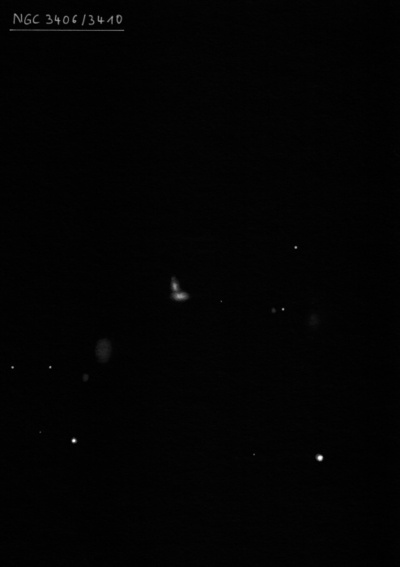
Located in a field with several mag 11 stars and situated between mag 9 SAO 277806 8' NE and mag 8.9 SAO 27796 4.8' SW. Forms a close pair with NGC 3410 1.8' SE.
John Herschel discovered NGC 3406 = h771 on 17 Feb 1831 (sweep 328) and recorded "pB; 2nd class; R; pgbM; among many stars. His position matches UGC 5970.
C.E. Burton, LdR's observer on 17 Mar 1868, recorded "Suspected to be triple, principal Nucl being double in direction sp nf, B point in p edge of sp part. Neby susp from this p with a 3rd knot in it." On 1 Apr 1878 Dreyer observed the field again, discovered nearby NGC 3410, and noted "preceding one [NGC 3406] pB, pL irr R gmbM. 2 points of condensation, brighter one sp centre..." The fainter northeast nucleus is the merged companion LEDA 93106, though for some reason Dreyer didn't even note the galaxy as double in the NGC description.
400/500mm - 17.5" (4/22/95): moderately bright, fairly small, elongated 3:2 WSW-ENE. Visually this appeared as a double system with a very small bright core and stellar nucleus that was offset at the southwest end and a faint extension to the northeast of this core [verified later on the POSS].
Notes by Steve Gottlieb
NGC 3737
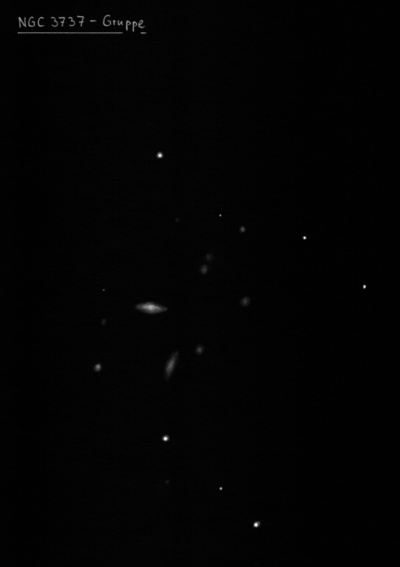
William Herschel discovered NGC 3737 = H III-772 on 14 Apr 1789 (sweep 920) and recorded "vF, stellar neb." His position is accurate (discovered immediately after NGC 3733). d'Arrest also measured two accurate positions.
400/500mm - 17.5" (3/19/88): fairly faint, very small, round. Forms a pair with CGCG 268-057 = NGC 3737A 1.3' SW. The companion appeared extremely faint, very small, slightly elongated. Member of AGC 1318.
Notes by Steve Gottlieb
NGC 5278
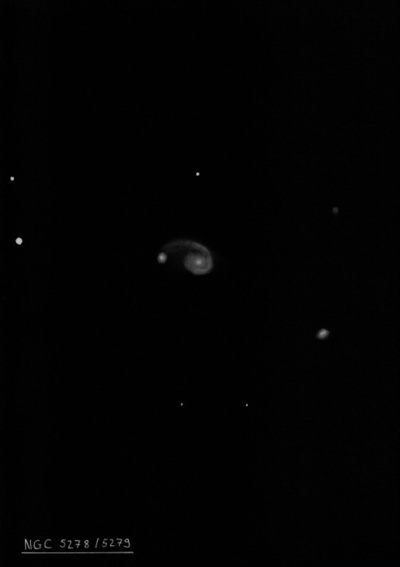
William Herschel discovered NGC 5278 = H II-798 = h1665 on 14 Apr 1789 (sweep 921) and noted "pB, E, 1 1/2' long and 1/2' br." His position is 2' northwest of this double system. JH resolved it and recorded "vF; double neb; pos = 73° by microm; a large star follows dist = 15' +/-." The field was sketched on 9 Apr 1874 at Birr Castle and a "star" labeled "epsilon" actually corresponds with UGC 8671.
400/500mm - 17.5" (6/18/93): fairly faint, fairly small, round, 45" diameter, very weakly concentrated core. Forms a double system with NGC 5279 just off the ENE edge 40" between centers. A mag 13.5 star lies 1.7' NNW. Located 8.1' WSW of mag 6.9 SAO 28858.
600/800mm - 24" (6/21/20): at 375x; moderately bright, fairly small, oval 4:3 WSW-ENE, ~36"x27", brighter elongated core. I saw of hint of the spiral arm on the north side, but no indication of the bridge connecting to NGC 5279.
UGC 8671, located 2.7' SW, was dominated by a 13th magnitude quasi-stellar nucleus. The halo was barely detected as a very diffuse, low surface brightness glow mainly west of the nucleus.
900/1200mm - 48" (5/3/19): at 545x and 813x; bright, fairly small, slightly elongated, bright core. This is an interacting (Arp 239 = VV 19) one-armed spiral with a diffuse bridge to NGC 5279 0.6' ENE of center. The single arm wraps tightly around the south side to the west and then separates on the north side. There was a brightening along the south edge that gave the impression of an arm, though it hugged the core too tightly to be resolved. But starting on the west side a straight spiral arm was evident extending NE. The arm dimmed suddenly into low surface brightness haze that extended further east to the north side of NGC 5279, merging with its northern spiral arm. The pair is located 8' SW of mag 6.9 HD 119549.
MCG +09-22-094, located 2.8' WNW, appeared fairly faint, fairly small, very thin edge-on ~6:1 N-S, ~0.6'x0.1', low even surface brightness.
UGC 8671, located 2.7' SW, appeared bright, fairly small, slightly elongated ~E-W, sharply concentrated with an intensely bright core!
AGC 1783, with up to 18 ultra-dim IC members observed by Barnard and Burnham, is ~15' ESE.
Notes by Steve Gottlieb
NGC 2684
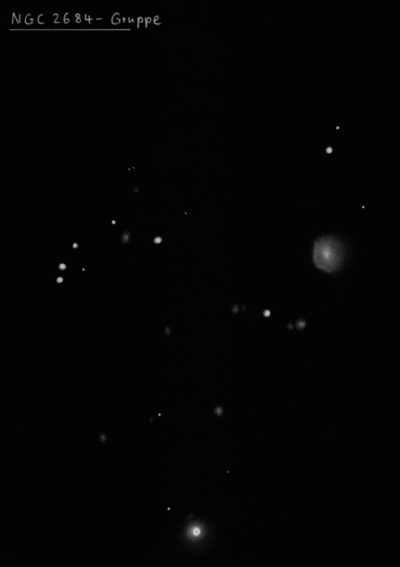
William Herschel discovered NGC 2684 = H III-712 = h533 on 9 Mar 1788 (sweep 815) and reported "eF, cS, resolvable, preceding some faint stars." His position is just 1' too far northwest. John Herschel recorded on 8 Mar 1831 (sweep 330) "vF; pL; R; 30"; a *12 m s f and on 13 m, n p." The two stars are 1.4' ESE and 1.9' N. Three extremely faint companions to NGC 2684 were discovered by LdR.
400/500mm - 17.5" (3/8/97): fairly faint, fairly small, elongated 4:3 SW-NE, 1.0'x0.7', just a broad weak concentration. Two mag 12-13 stars lie 2' N and 1.5' ESE. Brightest of three in a close group. The faintest members NGC 2688 and NGC 2689 were not visible.
17.5" (3/16/96): fairly faint, fairly small, slightly elongated WSW-ENE, 1.0'x0.8', weak concetration. A mag 13 star is 1.5' ESE and a mag 12.5 star lies 1.9' N. Brightest in a group of extremely faint galaxies including NGC 2687 and NGC 2686 close following.
Notes by Steve Gottlieb
NGC 5526
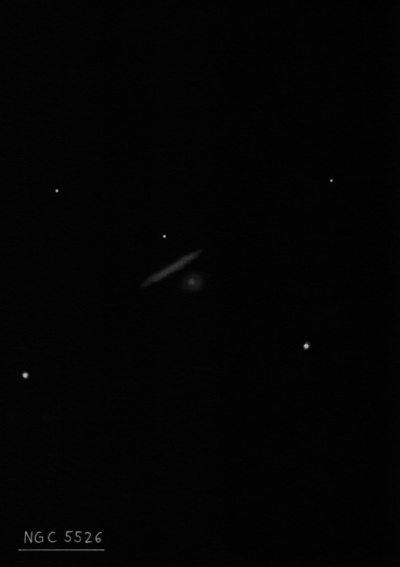
William Herschel discovered NGC 5526 = H III-804 = h1763 on 17 Apr 1789 (sweep 924) and noted "cF, S, E." His position and description matches UGC 9115. He observed the galaxy again on 17 Mar 1790 (sweep 948), recorded it again as III-835 at nearly the same position (CH's reduction). JH combined the two H-designations in the GC.
400/500mm - 17.5" (5/27/95): very faint, thin edge-on 6:1 NW-SE, 1.2'x0.2'. Appears as a low surface brightness sliver with no concentration. A mag 14 star is 0.8' NNE of center.
600/800mm - 24" (6/3/19): at 322x; moderately bright and large, very nice thin edge-on 6:1 NW-SE, ~1.2'x0.2', brighter elongated core. A mag 14.3 star is 40" N.
Forms a close pair with PGC 50803, just 30" SW. The apparent companion appeared extremely faint, very small, round, at most 10" diameter. Required averted to glimpse but repeatable in same position perhaps 20% of the time.
24" (7/12/18): at 375x; faint, moderately large, very thin edge-on 7:1 NW-SE, ~70"x10", fairly low nearly even surface brightness with only a slightly brighter core. A mag 14.3 star is 40" NNE of center.
MCG +10-20-084 = PGC 50803 forms a very close pair just off the west side, 0.5' from center. It appeared very faint, round, 12" diameter. This apparent companion lies far in the background (5.7 times the distance) at 540 million l.y.
Notes by Steve Gottlieb
UGC 5336
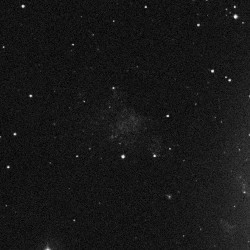
This M81 companion is a dwarf irregular or Magellanic system discovered by Sidney van den Bergh in 1959 and is similar to IC 1613. Holmberg IX has the youngest mean stellar population age of any nearby galaxy and may be a young tidal dwarf assembled from gravitational collapse of gas and stars stripped off during the last close encounter of M81 with M82 (see http://arxiv.org/PS_cache/arxiv/pdf/0802/0802.4446v1.pdf)
900/1200mm - 48" (4/15/10): Holmberg IX is located just 10.5' E of the center of M81. With this dwarf galaxy centered in the eyepiece, the outer halo of M81 was visible near the edge of the field. At 330x Holmberg IX appeared very faint, fairly large, 2' diameter, round, low even surface brightness with no noticeable concentration. The galaxy is nestled within a kite asterism including a mag 13 star 1.3' S.
Notes by Steve Gottlieb
NGC 4054
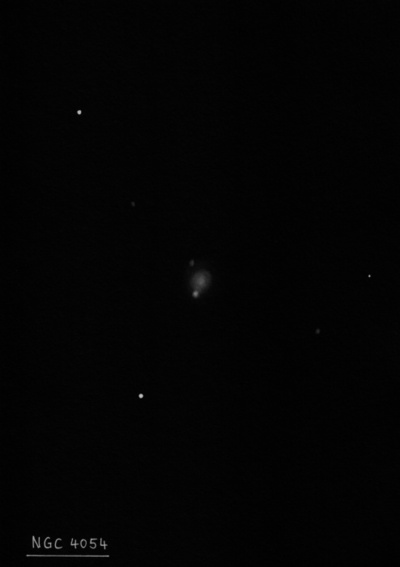
William Herschel discovered NGC 4054 = H III-794 on 17 Apr 1789 (sweep 923) and noted "eF, S, verified by 300." His position is 1.5' north of PGC 38078. Bigourdan wasn't able to find this triple system with the 12-inch refractor at the Paris Observatory (too faint?).
400/500mm - 16" LX200 (4/14/07): very faint, very small, slightly elongated, 20"x15" diameter. This is a triple system, though it initially appeared single. After careful viewing an extremely faint "star" occasionally popped out on the southeast edge. This virtually stellar object is VV 136b = LEDA 3547623.
600/800mm - 24" (6/4/16): at 322x; the western and largest component (VV 136a) of the triple system NGC 4054 appeared faint, small, slightly elongated 20"x15", low surface brightness. The southeast component (VV 136b) is smaller but significantly higher surface brightness and was noted as fairly faint, very small, elongated 12"x9" E-W. The centers of these small galaxies are separated by just 15". VV 136c, the northeast component, was not seen.
900/1200mm - 48" (4/20/17): at 488x; NGC 4054 is a close triple (VV 136) that fits in a 30" circle. VV 136a is the largest component; it appeared moderately bright, fairly small, oval 4:3 or 3:2 E-W, ~24"x15". The galaxy is diffuse with a fairly low surface brightness and only a weakly brighter nucleus. VV 136b, on the southeast side [15" between centers], appeared fairly bright, very small, slightly elongated, ~12"x9". The surface brightness is very high (easily the highest of the trio) and peaks at a stellar nucleus. VV 136c, on the northeast side [20" between centers], appeared faint to fairly faint, very small, elongated 2:1 NNW-SSE, ~15"x8".
Notes by Steve Gottlieb
NGC 5471
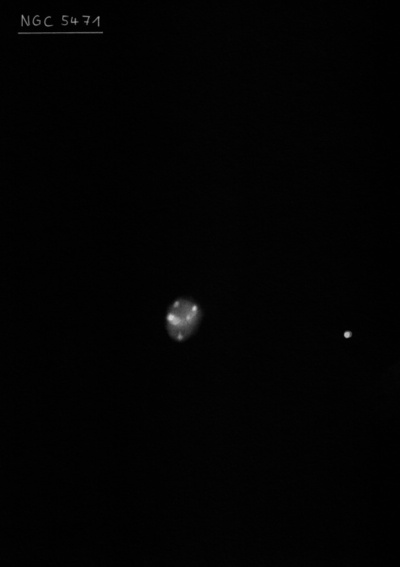
Heinrich d'Arrest discovered NGC 5471 on 22 Aug 1863 with the 11-inch refractor at Copenhagen and measured it on 5 different nights. He noted the mag 13 star that precedes by 9 sec of RA and questioned if this object was H III-789 with a 30 sec error in RA. MCG misclassifies this HII region as a galaxy (MCG +09-23-030).
400/500mm - 17.5" (6/7/97): this is one of brightest HII regions in M101, on the extreme NE end of the galaxy 11.5' from center. Appears as a moderately bright knot, ~20" diameter. This HII region stands out well due to its isolation and fairly high surface brightness with crisp halo.
600/800mm - 24" (5/24/20): one of the most prominent HII regions in M101, situated 11.5' ENE of center, beyond the visible edge of the galaxy. At 375x it appeared very bright, fairly small, round, ~20" diameter, high surface brightness. HII region M101-A is 3' NW.
Notes by Steve Gottlieb
NGC 3690A
William Herschel discovered NGC 3690 = H I-247 = h896 on 18 Mar 1790 (sweep 951) and recorded "pB, lE, mbM." On 9 Apr 1793 (sweep 1039) he logged "vB, pL, lE near the parallel, but a little from nf to sp." JH reported "B; R; pgbM. Query whether there be not a * excentric towards the south-following side." The "star" may refer to the companion on the south side. On 27 Jan 1852, LdR's assistant Bindon Stoney described the system as "Neb div into two parts, faint appendage np about one dia distant."
Swift also noticed it was double in 1883, writing in Sidereal Messenger IV (p39), "mentioned to all observers as very little elongated. Chancing to run across it with a power of 132, I immediately suspected it to be a close double, which suspicion a power of 200 confirmed. It is probably the closest double nebula known." Swift reobserved the galaxy on 18 Apr 1892 (list X) and noted "vs, close D with [NGC] 3690, suspected with 132, ver with 200". This is nearly identical to his 1883 comments. Dreyer entered Stoney's and Swift's second component as IC 694 -- but did they apply to the same object?
Usually, IC 694 is identified as the southwest component of the interacting double system NGC 3690 and this is likely what Swift resolved in his first observation. But Stoney's earlier observation clearly resolved NGC 3690 into two components as well as picking up the extremely faint 16th mag galaxy (MCG +10-17-002a = VV 118c) "one diameter" NW of the NGC 3690 system. Based on Stoney's observation, it is reasonable to assign IC 694 or IC 694B to MCG +10-17-002a = VV 118c.
400/500mm - 17.5" (4/1/95): NGC 3690 is a disrupted, interacting double system (Arp 299). This unusual pair appears moderately bright, fairly small, elongated E-W. The appearance is confusing with two very small "knots" in a common halo elongated E-W (20" between centers). On the west side is a fairly bright virtually stellar "knot", which is probably the nucleus of the brighter member of NGC 3690. There is a small fainter unconcentrated extension on the following end and the two components are not individually resolved. With averted vision, IC 694 was barely glimpsed as an extremely faint spot about 1' NW.
17.5" (3/19/88): fairly bright, moderately large, elongated ~E-W, irregular, mottled appearance. A mag 14 star is superimposed on the west side and an extremely faint mag 15.5 star or knot is involved. This is a disrupted interacting system which includes IC 694.
900/1200mm - 48" (5/12/12): at 488x, the southwest component (VV 118b) of NGC 3690 appeared as a very bright, elongated, irregular knot of high surface brightness. Contains a very bright, quasi-stellar nucleus. The northeast component (VV 118a) is the larger of the merged interacting pair and appeared bright, moderately large, ~1' diameter, small very bright core. A very low surface, asymmetric halo extends on the northwest side of the bright pair. The southwest component is generally misidentified as IC 694, which is described below.
VV 118d/e, probably HII regions, are just 45" NW of NGC 3690 (just outside the halo). Occasionally an extremely faint and small glow popped in this position, 6"-8" diameter. IC 694, ~1' NW of the bright pair, was easily visible as a fairly faint, slightly elongated glow, 15"x12", weak concentration. PGC 35345 (the brighter component of Arp 296) lies 2.6' NE. It was also a direct vision, fairly faint glow, fairly small, oval 4:3 NW-SE, 24"x18", increasing to a very small brighter core.
Notes by Steve Gottlieb
UGC 8335
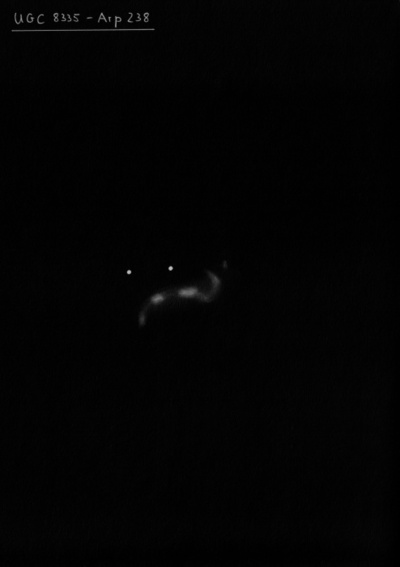
600/800mm - 24" (5/30/16): at 322x; both components of Arp 238 were seen immediately. MCG +10-19-056, the northwest component, is faint, small, elongated 4:3 ~E-W, 16"x12". The brighter southeast component is fairly faint, small, elongated 4:3 or 5:4, 20"x15". There was a small gap between the pair and neither tidal tails were seen. A mag 14 star is 35" NE of MCG +10-19-056 and a slightly brighter mag 13.5 star is 40" NE of MCG +10-19-057 with the separation and orientation of the stars very similar to the cores of the galaxies! CGCG 294-027 is 11' NW.
900/1200mm - 48" (5/14/12): MCG +10-19-056, the northwest member of Arp 238 has a slightly elongated bright core, ~20"x15" that gradually increases to the center. At the west side of the core a very faint "arm" extends ~15" NW then hooks a very short distance north. The core of similar MCG +10-19-057 = VV 250a is just 36" between centers with the two galaxies faintly connected at the center.
The southeast member MCG +10-19-057 has a bright round core ~15" diameter that increases to the center. The core is similar to the northwest galaxy, but has a slightly higher surface brightness. The extension or tidal arm attached at the east end was not seen. By an unusual coincidence, two similar stars are very close in the same relative orientation and separation as the cores of the galaxies! A mag 13.5 star lies 40" NE of MCG +10-19-057 and a mag 14.2 star is 32" NE of MCG +10-19-056!
This is a highly disrupted double system with a bridge and streamers.
Notes by Steve Gottlieb
UGC 5028
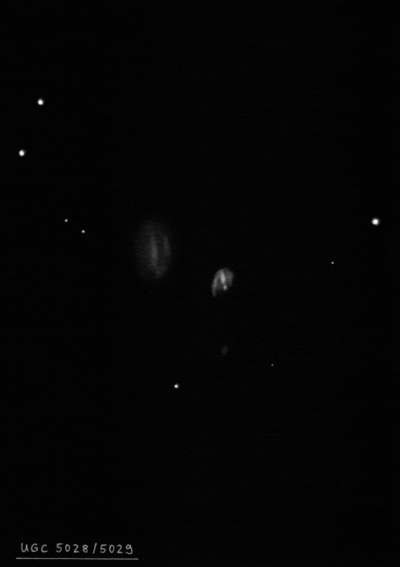
400/500mm - 18" (4/14/12): at 225x the western component of Arp 300 appeared fairly faint, fairly small, elongated 4:3 ~NNW-SSE, ~24"x18", brighter core. Forms a close pair with UGC 5029 just 1.2' ENE, the duo forming Arp 300. UGC 5028 is smaller but has a higher surface brightness than UGC 5029.
Notes by Steve Gottlieb
UGC 6865
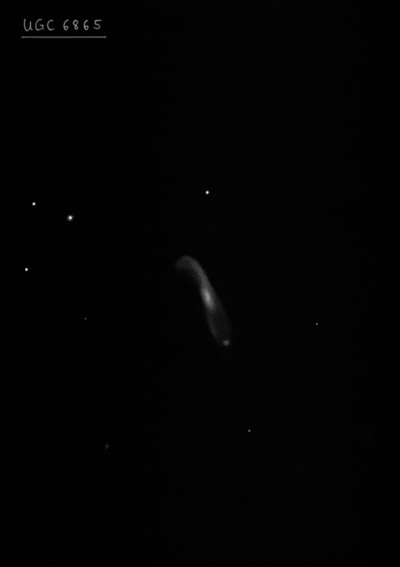
900/1200mm - 48" (4/19/17): at 375x and 488x; bright, fairly large, edge-on 3:1 or 7:2 NW-SE, ~1.4'x0.4'. Very unusual asymmetric appearance with two thin spiral arms. Contains a bright, relatively large oval core NW-SE. A very thin bright arm stretches from the west side of the core towards the northeast, bending very slightly to the east. A symmetrically placed thin bright arm is attached on the east side of the core and stretches nearly straight southwest along the eastern flank, heading towards VV 286b, a merged companion ~45" SW of center at the edge of the halo. The surface brightness of the halo has a much lower, irregular surface brightness east of the northern arm and west of the southern arm. At 488x, VV 286b (interacting companion at the southwest end) appeared fairly faint to moderately bright, fairly small, oval 5:3 E-W, ~15"x9".
Notes by Steve Gottlieb
UGC 8696
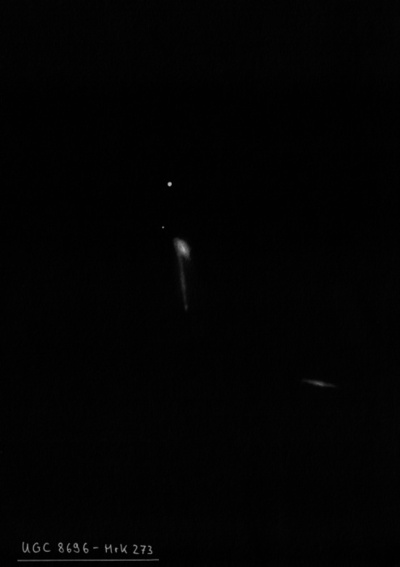
This Seyfert and ultraluminous infrared galaxy is commonly known as Mrk 273. It contains a double nucleus (1" separation)) with a single, spectacular tidal tail 130,000 light-years long and a 'ring' of star formation. Much of the activity in the system is associated with the northern nucleus where there is a considerable amount of young star formation.
400/500mm - 17.5" (6/18/93): faint, very small, very compact (core viewed) but hint of extension (tail?) to S. A mag 13 star lies 1' N. Located 4.5' W of mag 6.5 SAO 28878 which detracts from viewing. Forms a pair with MCG +09-23-002 3' WSW.
600/800mm - 24" (6/21/20): at 375x; fairly faint, small, oval 3:2 N-S, ~18"x12". Occasionally I seemed to glimpse an extension (tidal tail) to the south, though it was too faint to estimate a length and difficult to confirm. MCG +09-23-002 lies 3.4' SW and MCG +09-23-003 is 6' N. Located 4.3' W of mag 6.5 HD 11999.
900/1200mm - 82" (5/5/19, McDonald Observatory): at 613x; the main body of Mrk 273 appeared bright, moderately large, elongated 5:3 ~N-S. It was strongly concentrated with a very bright elongated core that increased to a nearly stellar nucleus. A subtle bulge was noticed on the SW edge. This is probably a merged interacting companion [on the SDSS the "bulge" has a blue color]. A very easy, large narrow tidal tail extended south as a very long "spike", perhaps 40"x6"! A mag 16.4 star is 0.6' NE. MCG +09-23-002, a thin edge-on, lies 3.4' SW.
Notes by Steve Gottlieb
HCG 41
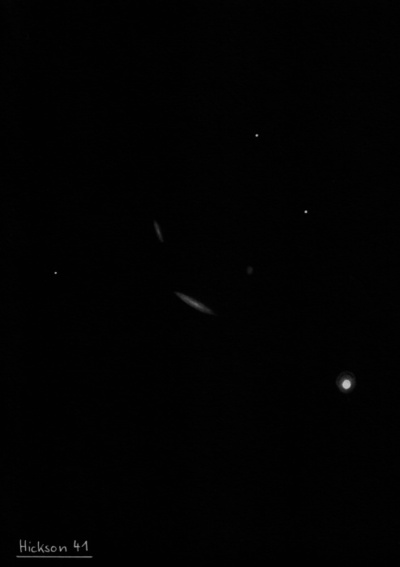
| Type | GALCL [S1] |
| RA | 09:57:39.6 |
| Dec | +45:14:22.0 |
| major_axis | 5.3' |
| mag | 11.9 |
| surface_bright | 99.9 |
HCG 56
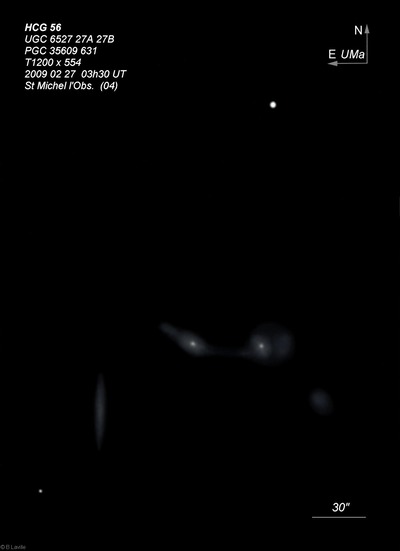
| Type | GALCL [S3] |
| RA | 11:32:31.9 |
| Dec | +52:56:55.0 |
| major_axis | 2.7' |
| mag | 12.2 |
| surface_bright | 99.9 |
UGC 5459
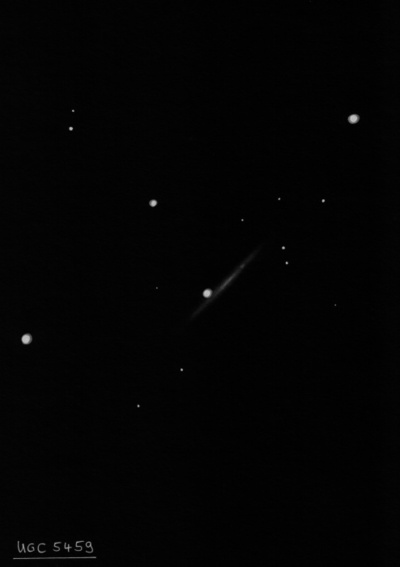
| Type | GX [Sc] |
| RA | 10:08:10.1 |
| Dec | +53:05:01.0 |
| major_axis | 3.8' |
| minor_axis | 42.0'' |
| position_angle | 131.0 |
| mag | 12.6 |
| surface_bright | 14.1 |
HCG 60
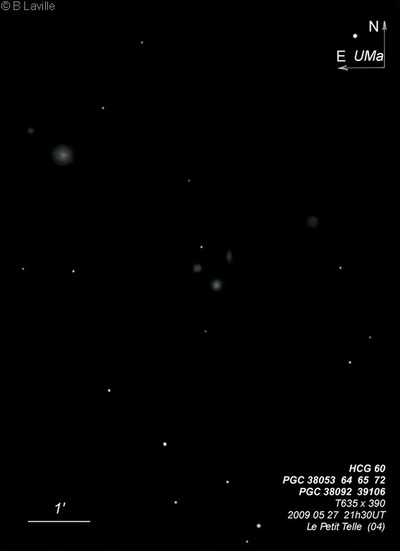
| Type | GALCL [E2] |
| RA | 12:03:05.1 |
| Dec | +51:41:35.0 |
| major_axis | 3.0' |
| mag | 13.4 |
| surface_bright | 99.9 |
HCG 45
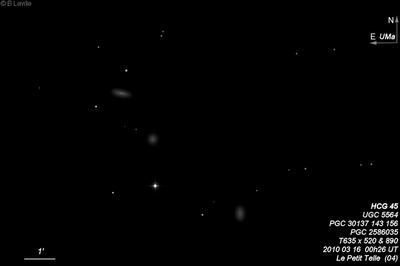
| Type | GALCL [S1] |
| RA | 10:19:11.3 |
| Dec | +59:06:35.0 |
| major_axis | 4.4' |
| mag | 13.5 |
| surface_bright | 99.9 |
UGC 8058
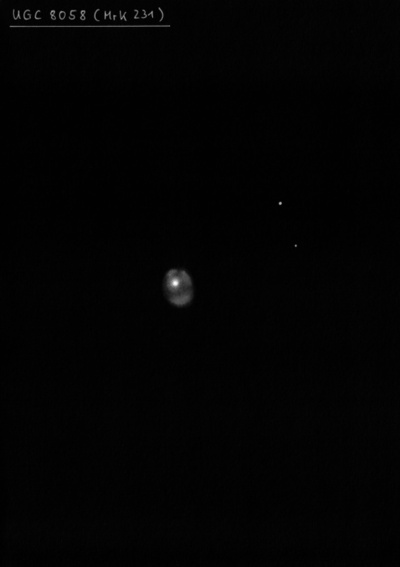
| Type | GX [Scpec] |
| RA | 12:56:14.3 |
| Dec | +56:52:25.0 |
| major_axis | 84.0'' |
| minor_axis | 54.0'' |
| position_angle | 10.0 |
| mag | 13.7 |
| surface_bright | 14.1 |
HCG 66
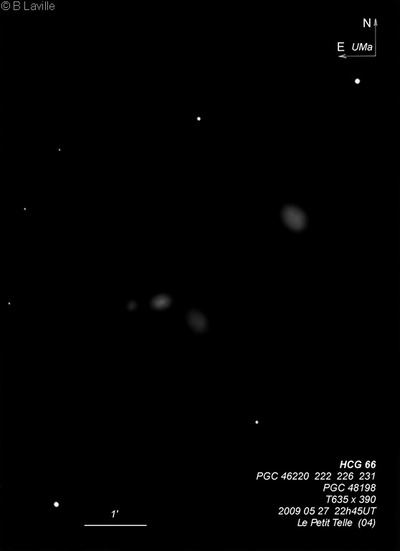
| Type | GALCL [E1] |
| RA | 13:38:33.5 |
| Dec | +57:18:16.0 |
| major_axis | 78.0'' |
| mag | 13.8 |
| surface_bright | 99.9 |
UGC 5055
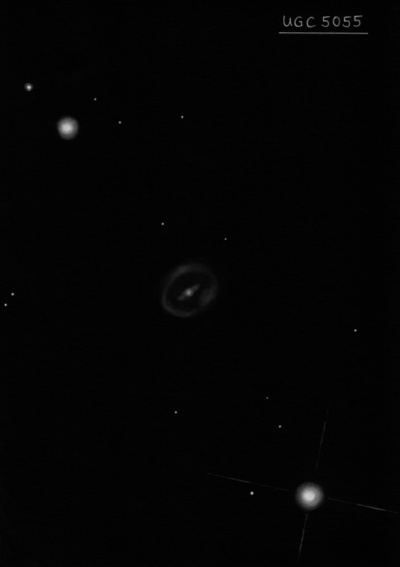
| Type | GX [SBb] |
| RA | 09:30:11.8 |
| Dec | +55:51:09.0 |
| major_axis | 84.0'' |
| minor_axis | 78.0'' |
| mag | 14.0 |
| surface_bright | 14.5 |
UGC 5904
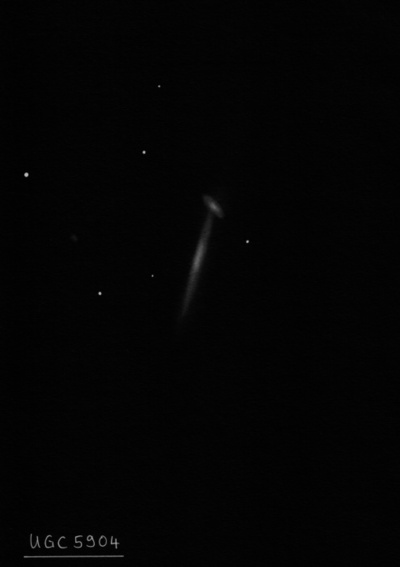
| Type | GX [Sb] |
| RA | 10:48:37.9 |
| Dec | +66:21:43.0 |
| major_axis | 2.5' |
| minor_axis | 36.0'' |
| position_angle | 152.0 |
| mag | 14.1 |
| surface_bright | 14.9 |
UGC 4719
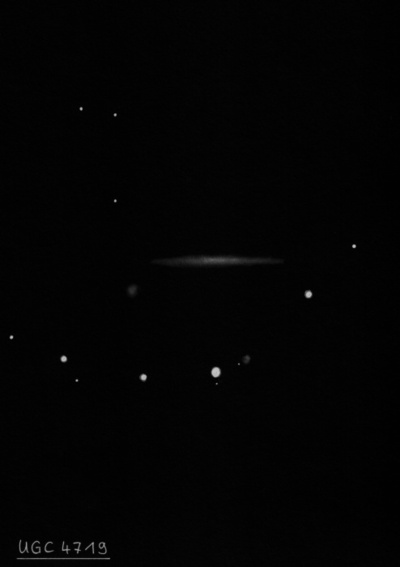
| Type | GX [Sc] |
| RA | 09:00:38.2 |
| Dec | +50:40:42.0 |
| major_axis | 2.6' |
| minor_axis | 24.0'' |
| position_angle | 95.0 |
| mag | 14.2 |
| surface_bright | 14.6 |
Pal 4
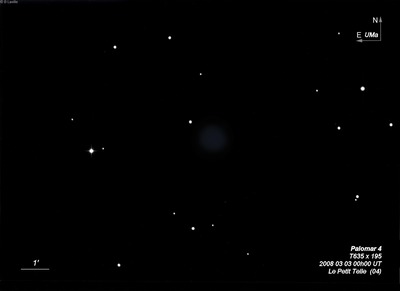
| Type | GC [XII] |
| RA | 11:29:18.0 |
| Dec | +28:58:00.0 |
| major_axis | 78.0'' |
| mag | 14.2 |
| surface_bright | 14.5 |
HCG 49
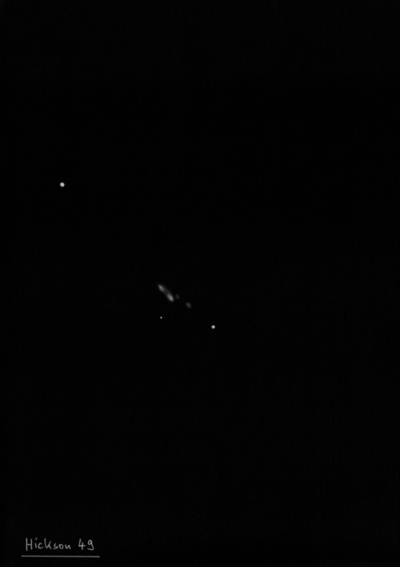
| Type | GALCL [E2] |
| RA | 10:56:36.5 |
| Dec | +67:10:45.0 |
| major_axis | 72.0'' |
| mag | 14.4 |
| surface_bright | 99.9 |
HCG 50
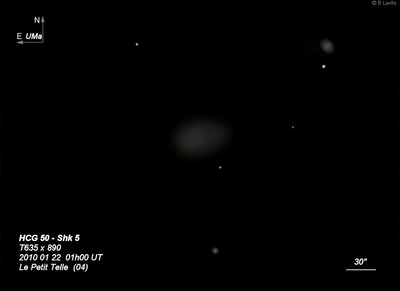
| Type | GALCL [E2] |
| RA | 11:17:06.1 |
| Dec | +54:55:07.0 |
| major_axis | 54.0'' |
| mag | 14.4 |
| surface_bright | 99.9 |
UGC 5479
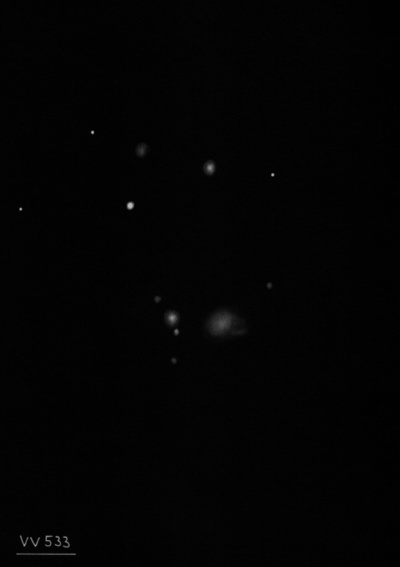
| Type | GX [Sc] |
| RA | 10:10:09.6 |
| Dec | +54:30:13.0 |
| major_axis | 66.0'' |
| minor_axis | 42.0'' |
| position_angle | 100.0 |
| mag | 14.4 |
| surface_bright | 14.1 |
Abell 28
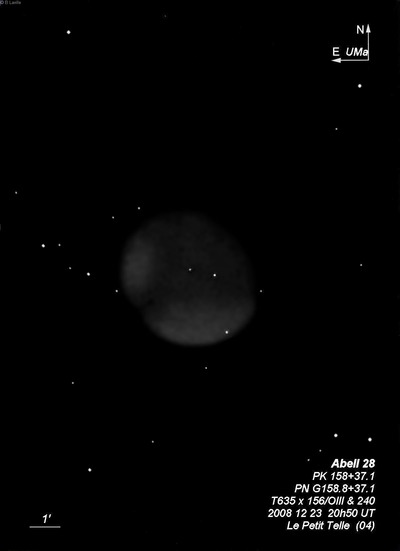
| Type | PN [2b] |
| RA | 08:41:35.6 |
| Dec | +58:13:48.0 |
| major_axis | 4.7' |
| mag | 14.6 |
| surface_bright | 17.7 |
Abell 1377
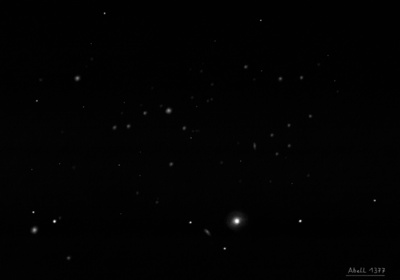
| Type | GALCL [13III] |
| RA | 11:47:06.0 |
| Dec | +55:44:00.0 |
| major_axis | 20.2' |
| mag | 15.0 |
PGC 33423
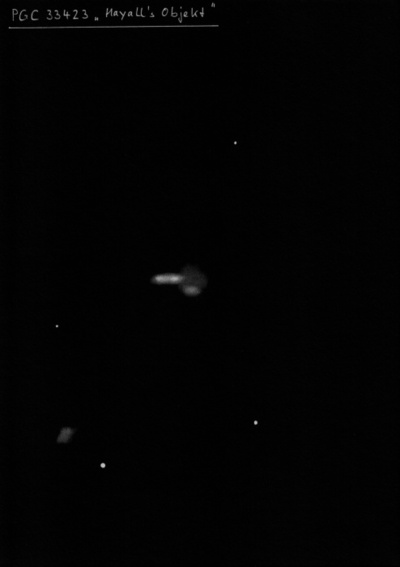
| Type | GX [Pec] |
| RA | 11:03:54.0 |
| Dec | +40:50:00.0 |
| major_axis | 18.0'' |
| minor_axis | 12.0'' |
| position_angle | 94.0 |
| mag | 15.0 |
| surface_bright | 11.7 |
